
Self Introduction Speech – How To Write With Examples
First impressions are very important. Whether it is at school, work, or organization, your introduction is an audience’s first real chance to know you. It will have a huge impact on how they perceive you.
But the good news is: You get to control that narrative.
The key to a good self-introduction speech is balance. You want to present your accomplishments but without coming off as bragging. Typically, this type of speech is known as an “icebreaker” as it aims to break the ice and let others know you. This is your chance to establish good credibility.
Fear not! We will help you craft the best introduction speech with our outline, tips, as well as self-introduction speech samples.
Let’s get started!
Table of Contents
Self-introduction Speech Outline
Sample introduction speech topics, sample self introduction speech objectives, write the outline, including hobbies and interests, sell yourself, use short, simple sentences..
What exactly do you need to cover in your introduction speech? You might choose to include a wide variety of information but there are some things you should not miss. Some of them are as follows:
- What is your name?
- Where are you from?
- What are some of your main interests and hobbies?
- What has been your passion in life?
- Who has been your role model?
- Any fun facts that make you stand out.
- Your credibility or job title.
Tip: If possible you should definitely include a visual aid in the form of pictures to compliment your speech. Pictures of you, your travels, family, or pets are always endearing!

Writing a self-introduction speech always seems easy at first. Besides, you definitely know yourself the best. However, once you begin writing you can find yourself getting lost. What do you want to include in this speech? So, grab a pen and scan through the topics in the list below. Circle any of the ones that speak to you so that you have a better grasp of what direction you’d like to take with your speech.
- What event has played an important part in shaping your life? Tell the story and the lesson you’ve learned.
- What is your goal in life?
- Where are you from? Is there anything about your culture or traditions that you’d like to share?
- How do you like to spend your time?
- What are some of your pet peeves?
- Do you have any special skills that you’re proud of?
- What does a day in your shoes feel like?
- What have been some of the most important milestones in your life?
- Have there been any difficult times that guided your life?
- What is a topic you could talk about for hours?
- What is an object that is dearest to you?
- What quirks make you the individual you are?
Now that you have an idea on how to draft your outline, here are some objectives for you to tick off.
- First off, grab their attention. Just because it is your introduction does not mean that your opening has to be plain. Find something catchy and concise.
- Start with some background. Set up the stage and introduce who you are. Try to present it in chronological order.
- Build a story. The speech is about you but make sure you build a relatable story to keep the audience’s attention.
- Show, don’t tell. Instead of saying how reliable you are, tell a story that shows it.
- For conclusion, try to leave your audience with a takeaway. Whether from your experiences or from a relatable standpoint. Either that or you can build the story leading up to who you are right now and leave the stage on an inspirational note.
How to write a self-introduction speech?
Are you ready to write your self-introduction speech? We’ve got just the steps for you:
The outline of your speech is simply a skeletal draft of your speech. It can initially simply take the form of bullet points. What matters is you figure out what elements are going into the speech. Similarly, figure out what order you will be presenting these elements. Typically icebreakers follow a chronological order so that you can build up to the current you.
It is common to start with your roots. Pick out some childhood traits that are relatable or that make you stand out. You can build on this with stories, talk about your education, and go on to talk about how you got to where you are currently.
If you are introducing yourself in a work setting, make sure you link your interest to your ambition. It will project you in a good light to your superiors and will also make your hobbies a lot more relevant. This is also a great idea to keep your speech concise and to the point. From a professional standpoint, you should follow your hobbies with the steps you are taking to reach the goal. For example, “I’ve always been into sketching, but now I’m taking illustrator courses to put my designing skills to use.”
Your hobbies are a great insight into who you are in your free time. If you’re into a particular niche hobby like bird-watching or pottery, you might even end up finding others in the crowd with similar interests. Similarly, it is a great way to gain credibility on a certain subject.
When people talk about their passion, there is a certain twinkle in their eyes. This is such an endearing quality that is sure to get your audience to respond. Try to give a short insight into you pursuing the hobby or how you came about to discover it in the first place. It is much more effective than simply listing out your interests. Talk about what aspects of the hobby draw you to it. It can help the audience get the bigger picture in getting to know you.
If the icebreaker is being delivered in a much more formal setting, you might want to focus more on your personal skills than your hobbies. The audience there might be more interested in your soft skills than your love of photography.
It might help to list out all your hobbies, interests, and skills along with why you are drawn to those interests. It can help you draw a parallel between them and deliver a much more well-rounded speech.
Knowing a person is an endless process. We’re sure you must have gone through your own journey with highs, lows, milestones and learnings that could be their own feature movies. It can be difficult to decide what exactly gets to make it to the speech when all of it made you who you are. But the longer you pad your introduction, the less are the chances of people actually listening to it.
This is why your self-introduction speech needs to spend a good amount of time on the cutting floor as well. Assess your audience and try to think of it from their perspective. What is relevant? Also, think of the location and if your stories are appropriate for the setting. Make sure you respect the time by picking only the most relevant information and keeping it short.
Even if your usual style is something like self-deprecating humor, for this occasion try to present yourself in a much more positive light. You want to project confidence. This is the impression that most of these people are likely to remember, so make it a good one. Pick your traits and stories well.
A self-introduction speech is almost always a great floor to pitch yourself. When else will you get this open invitation to present yourself to potential clients? Remember, the aim is to boost yourself and not boast about yourself. If you talk too much about what you can do and have done, it is easy to sound pompous and turn people off.
Try to stick to the truth. Instead of listing accomplishments by the dozens, talk about a passion you had and how you turned it into an accomplishment. Stay humble when speaking of future aspirations. And most of all, be grateful. Show appreciation to the people who have helped you so far.
How you sell yourself is not just dependent on the words you speak but also on your delivery. All the words in the world won’t be able to make up for a meek delivery. So make sure you write from your heart as that will be the easiest to deliver. Work on your build-up so that the ending is satisfying. Don’t just give an account for accomplishments by the year. For example: talk about how curious you were about animals from early on, how you got into photography because it lets you keep a moment with you forever, and eventually you got into animal photography. This way, it feels like a complete story.
In a more professional setting, you’d say, “As a freelance photographer, I used my marketing background to promote myself and stayed active in networking. I learned that creativity is wonderful but paired with due diligence, it can get you to much greater heights.” It showcases your skills, your traits, as well as shows you as an individual that is constantly reflecting, learning, and growing. This is the sweet spot you are aiming for.
While we’ve stressed the importance of relatability and humility, it is also important to create your own place on stage. You cannot be yet another person with only music and travel as their interests. Think of things that make you unique.
Put your humble hat aside for a bit. If you’ve assisted in making a big project happen, mention it. Talk about how you’ve led a team through a crisis. Discuss your learning experiences. Present a before and after of a milestone to show how much a role has impacted who you are today. Even if the project wasn’t successful, you can talk about how you’d approach it differently in the present day.
Even for relatively common interests like travel, you can pick unique memories and what aspects of travel have changed you for the better. Take every opportunity to spin a story to showcase a trait or talent. Think of the unique things that make you, you.
It can be easy to get lost in your stories. Try not to ramble too much and stick to the point. When writing your script, use varied sentence structures to keep things interesting. It will help if you read it out loud or record yourself so you can track how you’re doing. Try not to use too much jargon. Keep it simple and clear.
Self-Introduction Speech Examples & Tips to Help You Be Confident & Calm
Here's how you can nail your self-introduction speech, without the sweaty palms! Go from nervous to natural with these tips.
It's time! The moment for your self-introduction speech is upon you. Are your palms sweating just at the thought? There are two secrets to making it easier to give an introduction speech about yourself: practice and preparation.
And with those two things already on your to-do list, we took care of some of the lifting for you with these self-introduction speech examples. Plus plenty of tips to help you not only get through it but get through it and feel good about it after. Yes, it is possible. And you're on your way!
Easy Self-introduction Speeches for School
It's the first day of school or of the semester. Perhaps you've found yourself in a new classroom halfway through the academic year. No fear, these intros will ease you into things and hook you a few new friends and classroom groupmates, too.
- Student Council Speech Ideas & Tips to Help You Win
- 47 Fun & Relaxing Things to Do When You Want to Unwind
- 15 Powerful Attention Getters for Any Type of Speech
Self-Introduction for Elementary or Middle School Kids
For the younger kiddos, these intros are all about who they are and what makes them happy.
- "Hi, everybody! My name is [Your Name], and I'm super excited to be in this class with all of you. I'm [Your Age] years old. I live with my family, and we have a dog named [Dog's Name] who likes to eat all my homework. I really love dinosaurs, especially the T-Rex because he's big but has tiny arms, just like my baby brother when he tries to reach for cookies on the high shelf. In my free time, I love building rocket ships from Legos. One day, I hope to become an astronaut and find aliens -- friendly ones, of course!"
- "Good morning, everyone! I'm [Your Name], and I'm really excited to be part of this class. I am [Your Age] years old. At home, I'm the queen/king of board games, although my cat [Cat's Name] often tries to join in and messes up the pieces. My favorite food is pizza, because who can say no to pizza? And when I grow up, I want to be a detective because I love solving mysteries, like where my missing socks go in the dryer. I'm looking forward to learning and having fun with all of you this year!"
Self-Introduction Speech for High Schoolers
Give new classmates an in or let people know that you're just like them so you can make friends once you find the cafeteria.
- "Hey everyone, I'm [Your Name]. I'm new here, so please go easy on me if I can't find my way to the cafeteria. A few facts about me: I love music and play the guitar -- it's like a six-stringed stress buster for me. I'm a total sci-fi geek. If you need someone to debate Star Wars vs. Star Trek, I'm your person! And I have a secret ambition: to try every ice cream flavor in the world. Looking forward to getting to know all of you."
Self-Introduction Speech for College Kids
A quip about your major is a great way to start, but you can also loop in anything you love (or avoid) on your campus too, even if it's the steps by the library that seem to go on for eternity.
- "Hello everyone! My name is [Your Name] and I'm majoring in [Your Major]. When I'm not elbow-deep in textbooks or caffeine, I love exploring the city, one coffee shop at a time. Yes, I'm a self-confessed coffee addict and my dream is to find the perfect cup of coffee. I also enjoy [Another Hobby], because what's life without a little variety, right? Excited to be on this journey with you all!"
Job Interview Self-Introduction Speech
There's nothing like the dreaded "tell us about yourself" comment at an interview. The good news? You won't have any more nightmares because this intro is the perfect way to ease into the answer.
- "Good morning/afternoon! I'm [Your Name], and it's a pleasure to meet you. I graduated from [Your University] with a degree in [Your Major], and since then, I've gained [Number of Years of Experience] years of experience in the [Your Field] field. During my previous role at [Your Previous Company], I was responsible for [Key Responsibility] and I [Describe a Key Achievement or Impact You Made]. What I particularly enjoyed about that role was the opportunity to [Something You Enjoyed that Relates to the New Job]. In my free time, I enjoy [Briefly Mention a Hobby], which helps me to [Explain How It Applies to the New Role]. For example, [Concrete Example of How Hobby Relates to Job]. I'm excited about the possibility of bringing my unique experience and passion for [Mention Something About the Company or Role] to this position. Thank you for this opportunity to interview."
- Wedding Reception Introductions for Every Type of Couple
Work Self-Introduction Speeches
Make a smooth, witty, and warm self-introduction when you land the job or want to kick off an introduction with ease.
Introduction for a New Job
You're the new kid on the block at the office, you have enough to learn, here's an easy intro on your first day before jumping in.
- "Hello team, I'm [Your Name]. I'm thrilled to be joining the [Company Name] family as your new [Your Job Title]. I come with a background in [Relevant Skills or Experience], and most recently, I was at [Previous Company] where I [Describe a Key Achievement or Project]. Outside work, I love [A Personal Interest or Hobby]. I look forward to collaborating with all of you and contributing to our shared success."
Introduction for a Presentation or Meeting
Before you launch into the important information, take a moment to let people know who you are, why you're giving this presentation, and why you're qualified to do it. After all, you've done all the hard work, allow your accolades to shine.
- "Good morning/afternoon everyone, for those who don't know me yet, I'm [Your Name], the [Your Job Title] here at [Company Name]. I oversee [Briefly Describe Your Responsibilities]. I've been with [Company Name] for [Duration at the Company], and before that, I worked at [Previous Company]. Today, I'm excited to discuss [Topic of Presentation or Meeting]. Although if you want to chat after, I also love [Hobby]."
Introduction for a Networking Event
You'll be introducing yourself a lot at networking, so now is the time to make yourself pop and be memorable.
- "Hello, I'm [Your Name], currently serving as a [Your Job Title] at [Company Name]. I've been in the [Your Industry] industry for [Number of Years], specializing in [Your Specialty]. When I'm not [Job-Related Activity], I like to [Personal Interest or Hobby]. I'm eager to meet like-minded professionals and see how we can help each other grow in our careers."
Introducing Yourself at a Funeral
Whether you're delivering a eulogy, poem, or making a brief introduction of yourself to other family and friends, you can rely on this intro to make things a little easier.
- "Good morning/afternoon, everyone. My name is [Your Name], and I had the honor of being [Deceased's Name]'s [Your Relation to the Deceased, e.g., friend, colleague, neighbor]. We shared many [memories/experiences] together, and I am here to pay my respects and celebrate the remarkable life they led. Their [specific quality or memory] has always stuck with me, and it is something I will carry in their memory."
How to Introduce Yourself at a Party
It's party time! Keep the intro laid back and casual.
- "Hi! I'm [Your Name]. I may know some of you from [How You Know Some People at the Party]. I'm [a brief sentence about yourself, e.g., your job, where you're from]. I'm a bit of a [Hobby] enthusiast, so if you ever want to chat about [Topic Related to Hobby], I'm all ears."
Examples of How to Introduce Yourself to a New Group
You're the newbie, and there's nothing wrong with that. Start your clean slate with a short and sweet intro.
- "Hello, everyone! My name is [Your Name]. I'm thrilled to be joining this group! I have always been passionate about [Your Hobby]. It all started when [A Short Story About How You Got Started With This Hobby]. Over the years, my love for it has only grown, and I've spent countless hours [Describe Something You Do Related to The Hobby].
- Apart from this, I'm [Something About Your Job or Other Interests]. In my day-to-day life, I'm a [Your Profession], which can be pretty demanding, but [Your Hobby] has always been my perfect stress-buster.
- I joined this group because I wanted to meet people who share this passion, learn from your experiences, and hopefully contribute with some of my own insights. I'm really excited to be a part of this community and can't wait to get to know all of you better!"
10 Tips for Writing and Making a Self-Introduction Speech
Here are some tips to keep in mind while writing and giving your self-introduction speech. The most important tip, however, is to do what feels natural and flows easily.
- Know Your Audience : Tailor your introduction to the context and the audience. A self-introduction at a professional event will be very different from one at a casual party.
- Start Strong: Grab the audience's attention from the beginning. You can start with an interesting fact about yourself, a short story, or a joke if the setting is informal.
- Keep It Brief: Your introduction should be concise and to the point. Stick to key details about who you are, what you do, and perhaps one or two interesting facts or hobbies.
- Be Authentic : Genuine introductions are the most memorable. Be honest about who you are and don't be afraid to show some personality.
- Highlight Key Moments : Especially in a professional setting, it can be helpful to highlight a few key experiences or achievements that have defined your career or personal life.
- End on a Positive Note: Conclude your introduction on a positive or forward-looking note. You could express excitement about the event or meeting, or share a hope or goal for the future.
- Practice, Practice, Practice : Rehearse your introduction speech so you can deliver it confidently and naturally. This will help reduce any nerves and ensure you come across as polished and professional.
- Be Engaging : Use body language to engage your audience. Make eye contact, smile, and use gestures where appropriate.
- Relate It to the Purpose of the Event : If there's a specific reason for your introduction (like starting a new job, or joining a club), make sure to mention your relationship to the event or group and your expectations or goals.
- Provide A Personal Touch : Share a little about your personal life (like a hobby or interest) to make your introduction more unique and memorable.
Remember, the goal is to introduce yourself effectively, not to tell your entire life story. Keep it brief, engaging, and genuine .
Introducing Yourself With Ease
Sit yourself in front of the mirror, and run through your lines like an actor for a play, and in no time at all, the words will flow and you'll find a natural cadence. You may even surprise yourself with how easily your introductions flows once you take the stage. Don't be surprised if people ask how you were so calm and cool.
- Games, topic printables & more
- The 4 main speech types
- Example speeches
- Commemorative
- Declamation
- Demonstration
- Informative
- Introduction
- Student Council
- Speech topics
- Poems to read aloud
- How to write a speech
- Using props/visual aids
- Acute anxiety help
- Breathing exercises
- Letting go - free e-course
- Using self-hypnosis
- Delivery overview
- 4 modes of delivery
- How to make cue cards
- How to read a speech
- 9 vocal aspects
- Vocal variety
- Diction/articulation
- Pronunciation
- Speaking rate
- How to use pauses
- Eye contact
- Body language
- Voice image
- Voice health
- Public speaking activities and games
- About me/contact
- How to write an introduction speech for a guest
- How to give a self-introduction speech
Give a great self-introduction speech!
- a step by step guide plus an example speech .
By: Susan Dugdale | Last modified: 11-28-2022
A self-introduction speech is often called for when a group of people get together first time. It could be a work-based seminar, a break-out group at a conference, a hobby group, or your new class at the start of the term. The occasions are numerous!
If you need to prepare short introduction speech about yourself, you're in the right place.
What's on this page

- the purpose of a self-introduction speech
- content guidelines - 6 areas to cover introducing yourself
- how to avoid blanking out under pressure and prepare a good speech at very short notice
- a 1-minute self-introduction speech example
- resources for more help
The purpose of a self-introduction speech
One thing a newly formed group generally shares is the need to make a bunch of strangers feel at ease: to quickly establish a sense of unity or belonging.
And one of commonest ways to achieve that, in a setting where people are expected to work collaboratively together, is to have each person give a brief 1–2-minute self-introduction speech. *
If you've not expecting it and have nothing prepared, that triggers a whole lot of questions about the purpose of the speech and what would be best to say. * This is not an elevator speech - i.e., a brief, carefully worked pitch highlighting your strengths and experience to encourage a potential employer or client... to consider taking you on.
You are already a member of the group. You don't need to pitch or advertise yourself. All you need to do is introduce yourself because these people don't know you.
The questions you ask yourself
Usually, the leader will start and around the members of the group you go, one by one.
- What will you say when it's your turn?
- What's the purpose of this speech? What could it to achieve for you if you do it well?
- What can you say that will interest people?
- What topics fit with the occasion?
- What will the people listening expect to hear?
- What tone do you use? Formal or informal?
- And more importantly, if you're anxious about public speaking, what will stop the fear of making a complete fool of yourself?
First impressions count, so let's look at the elements that go together to make a good introduction speech about yourself.
Return to Top
Self-introduction speech content areas
There are six content areas to cover. The first three are essential. The remaining three lift your speech from 'basic' to something a little more interesting.
- Stating your name clearly
- Placing yourself - where you are from, the organization you belong to, the position you currently hold
- Background - what can you share that is related to the group's core purpose for meeting? Is it an event, experience, a particular skill or educational qualification?
- Interest, passion or goal - what genuinely interests you? What drives you? Is there a personal goal you want to achieve through being a member of this group?
- Sharing personal details appropriate to the setting of your speech e.g., your hobbies or pet peeves.
- Unity - what do you share in common with someone else in the group? Can you reference something somebody speaking before you said?
Self-preservation techniques for nervous speakers
Ignore everyone else and focus on yourself.
If this is the first time you've made an introduction speech about yourself and, you're inclined to be tongue-tied, awkward and nervous, don't listen to what others are saying before you.
I know that seems rude, but the situation calls for self-preservation.
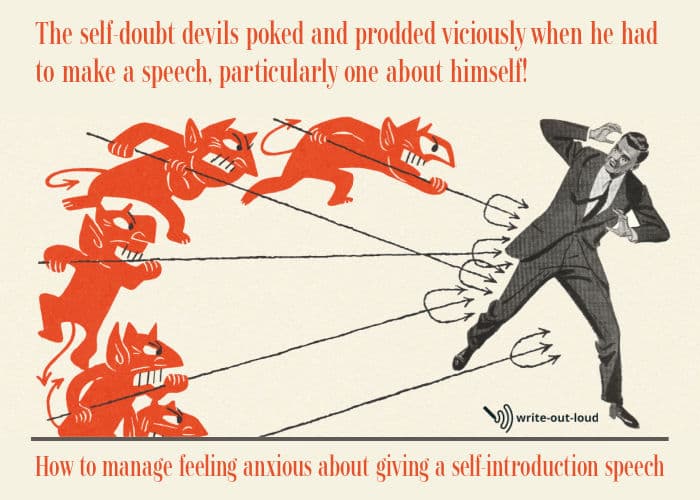
If you allow yourself to listen, you'll get mesmerized by everybody else's speeches and be unable to plan anything useful for yourself. That will heighten your anxiety.
Start with making some notes
Grab a piece of paper, or use the notes app on your phone, the moment the round-robin introduction is announced and start jotting down ideas.
Start with the first three items from the list above. That's the basic information: your name, where you are from and your background. Then add more as time permits.
Everything you put down should be relevant to the occasion and your audience. And remember to breathe well while you're doing it!
When we're anxious we tend to hold our breath which makes us feel worse. You'll find these breathing exercises help.
Watch the timing
Generally, the timing allowed for a self-introductory speech is between 1 - 2 minutes. (About 150-300 words.)
Going over that is poor form because it eats into the time allocated for everybody to speak. In addition, rambling on without being mindful of the larger group could be interpreted as boring and/or egotistical. Just try not to do it! ☺
Self-introduction speech example
Here's a simple short self-introduction speech sample. You can use it as a model to prepare your own speech. All up there are 130 words which will take approximately a minute to say.
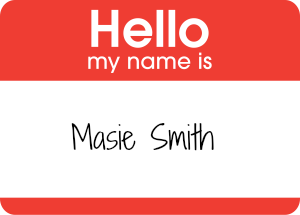
Hi everybody!
I'm Masie Smith, Senior Marketing Executive, from Watts and Frederick in Smalltown, Bigstate.
It's great to be finally here. I've been dreaming about the opportunity and possibilities of working collectively and directly with each other for a long time now. Jane and Sam can attest to that. There's been hours put in balancing the schedules to make it happen.
Webinars and email are fine, but nothing beats face to face.
Working collaboratively has always been a passion. Even in kindergarten I tried to set up a group-think session around a one swing and ten children problem.
Years later my master degree focused on harnessing group energy creatively. I've been inspired by agencies that got it right.
Sally you've already said it and I echo you. I'm excited!
Prepare and practice in readiness
If you know you have situations coming up that will call for a self-introduction speech start generating one ahead of time.
Make yourself an adaptable template using the core content elements listed above that you can use whatever the situation you are in.
Practicing your speech out loud will help you refine and hone your message.
It's well worth doing as these few words can set the way in which others view you. They can open doors, as well as close them!
With repetition you'll gain the confidence to speak for yourself concisely and cohesively. You'll find the temptation to succumb to a fit of the blithers will have vanished! (Thank goodness!)

Other related and useful pages:
- How to prepare and deliver an introduction speech for a guest speaker (with an example speech)
- How to write a speech introducing yourself . This is Wiki How's comprehensive overview of the process, with examples.
- Tips and techniques to manage public speaking anxiety
speaking out loud
Subscribe for FREE weekly alerts about what's new For more see speaking out loud

Top 10 popular pages
- Welcome speech
- Demonstration speech topics
- Impromptu speech topic cards
- Thank you quotes
- Impromptu public speaking topics
- Farewell speeches
- Phrases for welcome speeches
- Student council speeches
- Free sample eulogies
From fear to fun in 28 ways
A complete one stop resource to scuttle fear in the best of all possible ways - with laughter.

Useful pages
- Search this site
- About me & Contact
- Blogging Aloud
- Free e-course
- Privacy policy
©Copyright 2006-24 www.write-out-loud.com
Designed and built by Clickstream Designs
How Can I Write A Speech About Myself: 7 Tips
Table of contents
- 1.1 “Speech about me” plan example:
- 2 Common Mistakes You Must Avoid At All Cost
- 3 How To Make Your Autobiographical Speech Excellent?
- 4 Example Of A Speech
Why do you need to compose an autobiographical speech outline, and what is it at all? Its concept is to demonstrate one’s personality to achieve a specific goal. Make a competent self-presentation about yourself. You can achieve significant success in life because a person who understands how to present himself in a favourable light can always find a good job, maintain friendly relations with others, and influence people to achieve any goals.
How does one prepare an autobiographical speech and correctly present it? In this case, every detail is important. Our speech writing services have created detailed guidelines for you! Want to know how to write a speech about yourself? Well, we can help you with that as well, and the answers you seek are below.
7 Main Tips To Create A Persuasive Speech About Yourself
While writing a speech about you does not appear to be such a complicated task, there are a number of possible issues that you can face, which is why being aware of some efficient writing tips is not a bad idea! Therefore, if you are not sure how to write a speech of this kind, read the tips below and with their help, you will be able to create a perfect speech regardless of a lack of experience or a tight deadline! However, if you feel that you might have difficulties with writing your speech, you can always speech writing service at PapersOwl.
1. Gather information
Find out the most about where to whom and in which circumstances it will be necessary to present an informative speech, everything is important:
- the time of the performance and its timing;
- the place: the meeting room or the hall, the presence of a microphone;
- who is the audience: the number of listeners and speakers.
2. Make a plan
It is important to plan your paper. First, make it easier for you to track the time of the performance, and secondly, it helps you set priorities. Also, when making a plan, move from bigger points to smaller ones. The points should not be too long.
“Speech about me” plan example:
Introduction: The introduction should be short and simple. Start with the greeting and present yourself. State your name and surname, faculty, specialty, and course (if in a university). Add a hook to make it interesting. To make it flawless, look for good self-intro speech ideas.
Basic information part (the most informative part):
- Participation in academic events, contests, and competitions (indicate only those events or works that are relevant to the persuasive speech topics );
- Internships, work experience (indicate the type of work; indicate the place of work and position);
- Participation in public events (social activities within the university, not counting studies);
- Additional education (courses, certificates, training).
Additional information part:
- Knowledge of foreign languages (specify language and level of knowledge);
- Computer skills (list of computer programs that you work with);
Conclusion. Typically about plans for the future and ambitions:
- Continuing education (outline what kind of education you plan to receive after finishing college);
- Employment (you can specify the type and scope of activities in which you would like to work or the name of the positions that you are interested in).
It is important to write my speech well. However, it is only one small step in the whole process, after which you should spend enough time proofreading and editing it, making it as good as possible. Writing a persuasive speech should not take much effort. Make adjustments by reading the text again and again. Ask a friend to read your text or listen. It’s important to have an independent opinion, and maybe he or she will bring some new speech ideas, and you will know how to write a persuasive speech .

4. Keep in mind the details
If you do not know how to give a speech about other person or yourself, and it will be your first experience, you should pay attention to details. Wear clothes should fit the format and be comfortable. This will always make a good impression on the audience, your appearance will conclude a general impression of you, and this is why your appearance should be nice and appropriate. Keep this in mind.
Before the beginning of the speech, outline yourself, pause – pull out the papers, smile, and straighten the microphone. This will set the audience to a dialogue, and you will be given the opportunity to prepare and assess listeners psychologically.
Watch gestures. Sometimes, they speak louder than words. Hands are your helpers, so do not grip them behind your back and do not put them in your pockets, a crossed arm on the chest is evidence of a defensive position or lack of confidence. However, to freeze, like a monument, is also bad as it’s unnatural, so ensure that your movements during the performance are light and accurate, slightly subtle and unobtrusive.
6. Practice
Believe it or not, even public speakers can be nervous before public connection or speaking, but for newcomers. They are distinguished by the fact that they know how to cope with the excitement. The simplest thing you can do is to work through the speech, first read it to yourself, then read it aloud several times in front of a mirror.
7. Learn by heart
Be sure to ask your family, friends, or colleagues to listen to you. This is an excellent opportunity to practice and learn an engaging monologue with a nice tone that doesn’t sound like you are reading a piece of paper. It is very important to learn speech by heart to make your performance great and look confident when you speak in public.
If you feel lost while writing a speech about yourself, you can always hire an essay writer to help you create a compelling narrative. It is important to remember that you should be honest and confident when writing a speech about yourself. An experienced essay writer can help you create an outline and structure the speech according to your desired goals.

Common Mistakes You Must Avoid At All Cost
Your speech is a similar thing to communication skills in public speaking. Hence, we can see that the same tips should be used, and the same mistakes must be avoided. You may need this for professional connections or even for your best friend. If you are delivering this speech live, make sure to keep eye contact all the time. One of the main points here is to make sure you know what you are doing, and for that, you have to read the basics from above. They can help you more than you can imagine. Anyway, here are the mistakes you have to avoid.
- Not tailoring the speech for your audience An important piece of information here is that you need to tailor the speech for your audience. Is this for your family members or something else? The goal is to optimize your speech for the people who will hear it. Try to understand them more and realize what they need and what they want to hear, and then focus on that from the start. If you are writing about personal development, it is possible that a teacher will read it. Try to put an accent on education and similar elements.
- Using too much data Maybe you are writing about time attending apps, or you think that a rough draft is boring, so you add a lot of data to it. The mistake here is obvious. If you add tons of data to the speech, you will make it boring, and you will end up with a low grade. The goal is to make a speech interesting and not boring.
- Presenting a not inspiring speech The tone for the rest should be slow and casual. But, at the same time, it must be inspiring. One of the main points here is that if your speech can inspire, you are looking at a much better result. Yes, you can use body language here as well. That will make all things even better if you can use it.
- Not making a pause You need to use a research source and also use pauses. These can make a massive difference. They have been known for helping people understand speech better and easier. At the same time, they make the speech sound better and more professional. If you have to read it in front of a class (writing speech for a class), make sure you use pauses.
How To Make Your Autobiographical Speech Excellent?
It is impossible to write a speech about yourself and make it 100% perfect, but who needs it to be perfect? During the performance, anything can happen: the microphone will break, someone will sneeze loudly, or perhaps the lights will go out. Whatever happens, keep yourself calm and appear confused, react with humor and try to somehow beat the situation, so, you show that you completely control what is happening. At the end of the performance, be grateful to the listeners. If you still have any questions about how to write a letter about yourself, just sit and start to write it.
Keep in mind that this self-presentation does not end only in your performance. You present yourself further, answering any questions from teachers or people from the audience, so it is important to be ready for it.
- Free unlimited checks
- All common file formats
- Accurate results
- Intuitive interface
Example Of A Speech
The content of your speech must be detailed, simple, and straightforward. For this purpose, you need to know a few things. It must have a simple intro, an idea about your future plans, and something from your past. Once you have all of these, audience members and business partners will be impressed. Keep in mind that this is not as simple as it may sound. Hence, we will want to help you even more by providing an example of the speech. The example here will give you an excellent idea of what you should write and how to make the writing process simple but effective.
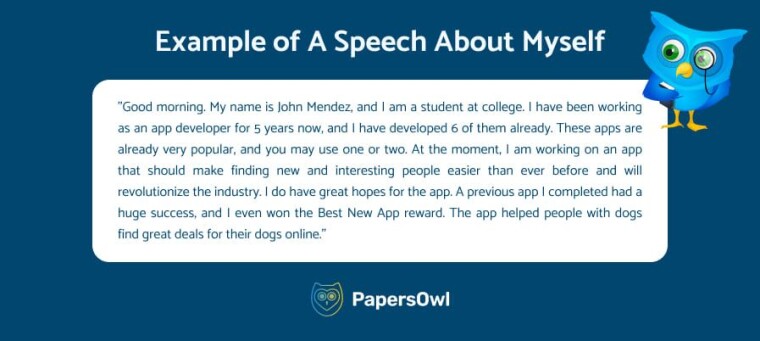
This is a short speech, but you get an idea of what is needed to include in these creations and what you need to make sure your speech contains. A good idea is not to go with a lot of details and use long sentences and complicated words. Your audience may get bored or may want you to speed things up. It is always a good idea to practice as well and try to create a speech that is ideal for you and can help you get the desired effect.
Readers also enjoyed

WHY WAIT? PLACE AN ORDER RIGHT NOW!
Just fill out the form, press the button, and have no worries!
We use cookies to give you the best experience possible. By continuing we’ll assume you board with our cookie policy.
- PRO Courses Guides New Tech Help Pro Expert Videos About wikiHow Pro Upgrade Sign In
- EDIT Edit this Article
- EXPLORE Tech Help Pro About Us Random Article Quizzes Request a New Article Community Dashboard This Or That Game Popular Categories Arts and Entertainment Artwork Books Movies Computers and Electronics Computers Phone Skills Technology Hacks Health Men's Health Mental Health Women's Health Relationships Dating Love Relationship Issues Hobbies and Crafts Crafts Drawing Games Education & Communication Communication Skills Personal Development Studying Personal Care and Style Fashion Hair Care Personal Hygiene Youth Personal Care School Stuff Dating All Categories Arts and Entertainment Finance and Business Home and Garden Relationship Quizzes Cars & Other Vehicles Food and Entertaining Personal Care and Style Sports and Fitness Computers and Electronics Health Pets and Animals Travel Education & Communication Hobbies and Crafts Philosophy and Religion Work World Family Life Holidays and Traditions Relationships Youth
- Browse Articles
- Learn Something New
- Quizzes Hot
- This Or That Game
- Train Your Brain
- Explore More
- Support wikiHow
- About wikiHow
- Log in / Sign up
- Education and Communications
- Communication Skills
- Public Speaking
- Speechwriting
How to Write a Speech Introducing Yourself
Last Updated: May 13, 2024 Fact Checked
This article was co-authored by Lynn Kirkham . Lynn Kirkham is a Professional Public Speaker and Founder of Yes You Can Speak, a San Francisco Bay Area-based public speaking educational business empowering thousands of professionals to take command of whatever stage they've been given - from job interviews, boardroom talks to TEDx and large conference platforms. Lynn was chosen as the official TEDx Berkeley speaker coach for the last four years and has worked with executives at Google, Facebook, Intuit, Genentech, Intel, VMware, and others. There are 15 references cited in this article, which can be found at the bottom of the page. This article has been fact-checked, ensuring the accuracy of any cited facts and confirming the authority of its sources. This article has been viewed 3,794,868 times.
First impressions have a big impact on how others perceive you, so how you introduce yourself to others is extremely important. Many people call an introductory speech an elevator speech, because it should be succinct enough that you could introduce yourself and tell someone about your goals or interests in the time it takes to ride an elevator. It may also be called an "icebreaker" speech, as it breaks the ice and lets others get to know you. [1] X Research source Consider your words carefully when you write a speech introducing yourself. Crafting a good self-introduction can either build or harm your credibility.
Sample Speeches

Preparing Your Speech

- State your name in the very first sentence of your speech. This can be very straightforward: "Good afternoon!/Good morning! My name is Deshawn Smith, and I am a computer programming student at the University of Arkansas."
- If the introduction is work-related, mention your interests and your career goals together in the same sentence. This will save on time and convey that your personal interests can serve your professional goals. For example, "I am working on an app that allows people to order pizza from their Twitter account."
- You may want to mention your education or professional training background, if it is relevant and appropriate. "This is the fifth app I've designed. My second app, which helped people locate dog parks near them, won an award at my university."

- If you are explaining your passion or goal and how it helped formed your progression up to this point, that can help you tell a compelling story about yourself. For example, if you're writing a speech for your college speech class , you might want to explain how you got into computers at an early age and why they're important to you now as you pursue your career goals.
- If, however, you are introducing yourself to potential clients at a business lunch, they are probably not interested in your hobbies. They will want to know what you are doing right now and what your skills are.
- Try writing one draft with your experience/hobbies and one without, and run both versions by an objective listener who can give you feedback before your speech.

- Highlight the qualities, skills and experience you have that are most relevant for the audience and occasion. For example, "Because of my background in app writing and my extensive network of professional connections, I have a strong grasp of what today's young professionals are looking for. My apps offer convenience and immediate gratification."
- You are trying to present yourself as a professional while making a strong and lasting impression.
- If you're trying to sell yourself to a group of new colleagues, you probably won't need to tell them about your family life, or anything outside of work that isn't directly relevant.

- You can simultaneously demonstrate your skills and experience, while presenting yourself as a forward-looking person who is always learning and developing. For example, you could say, "I spend a lot of time attending app conventions and conferences so I can learn what audiences are looking for. I pride myself on staying on the cutting edge of app design."
- Try to tie this into your broader outline of your career goals and personal development.
Revising and Practicing Your Speech

- Make sure that if this is an assignment, you stay within the assigned guidelines.
- If your speech is supposed to be 3-5 minutes, a 7-minute speech and a 2-minute speech are equally inappropriate.
- If you are giving a brief introductory speech in an interview , be certain that you don't go over the recommended time.

- Avoid long rambling sentences, and use direct and concise prose as much as possible.
- Think about your sentence structure carefully. Reading your speech out loud will help you determine when you have overly long sentences that need to be restructured.

- Practicing in front of other people will enable you to gauge whether your speech captures the interest of your listeners.
- Think about which parts of the speech were successful and which parts weren't.
- Try to get as much detailed feedback as possible by asking specific as well as general questions after your speech.
- As well as saying "how did you like the speech?", ask specifically what parts were the strongest and weakest.
- Check that you delivered a clear message by asking your practice audience what they took away from the speech.

- If you are staring down at a piece of paper all the time, the audience might struggle to truly engage with what you are saying.
- You can, however, bring an index card with bullet points, just in case you freeze up. You shouldn't write your whole speech on the card, just the main points you hope to cover.
- Think of the card as a point of reference, rather than a backup for your speech.
Planning Your Speech

- Who is the intended audience?
- What is the purpose of my introduction?
- What are the expectations others may have?

- Stick to one or two main points you want to convey about yourself. You can always add more if time allows it.
- Depending on the audience and function of your speech, you shouldn't allow the focus to become too narrow. For example, if you're introducing yourself to a crowd of prospective investors, you'd focus on your skills to build their confidence in you. If you're introducing yourself to a general audience -- say, for a speech class in college -- you can be a bit more wide-ranging.
- Remember that you're introducing yourself in general, and you want to present yourself as an interesting and rounded individual. [12] X Research source
- That doesn't mean you should spend time talking about your love of baseball when you are introducing yourself in a professional scenario.

- Are you hoping to win someone over to your point of view with this introduction, or to inspire/motivate someone to work hard under your leadership?
- All of these will affect the things you say in your introduction and the way you say them. [14] X Research source
Delivering Your Speech

- You can also try some visualization techniques to help ease your nervousness and give you confidence for your speech.
- Imagine the way you will feel when you have finished delivering your speech and are met with smiling faces and resounding applause. Then channel that confidence into the actual speech you are about to deliver.

- Avoid crossing your arms or clutching your hands.
- Don't stare down at the ground or cling to the table or lecture in front of you.
- Make eye contact across the room in a measured and controlled way. Avoid lingering on one person, but also avoid darting your eyes back and forth restlessly.
- Try making eye contact with one person on the left side of the room, then one person on the right side of the room. Shift across the room, but in a controlled way that feels natural and relaxed.

- Aim for a comfortable, conversational pace of dialogue.
- Practicing your speech in front of other people, or recording it and listening back are great ways to judge the tempo of your speech.

- Self-deprecating humor can help you come across as humble and likable. For example, if you've accidentally skipped forward in your speech and have to circle back, you could say something like, "And now I'm going to cycle back and tell you something I forgot before. If you wanted to get to know the "real me," you're seeing it now!"
- You can also make a quick, humorous nod to your mistake and move on. For example, if you come out and you mess up the very first line, you could say something like, "Wow, excuse me. Here I am so excited to tell you about myself that I've mixed up all my words. Let me try that again."
- Don't be too self-deprecating, however. You are still trying to ensure people remember you for your strengths and competencies. Move on quickly.
Expert Q&A

Reader Videos
Share a quick video tip and help bring articles to life with your friendly advice. Your insights could make a real difference and help millions of people!
- Improve eye contact with the audience. Be direct and move confidently during the speech. Thanks Helpful 19 Not Helpful 3
- Do not be afraid to make yourself sound good. After all, this is an introduction, and the first impression you will make. Thanks Helpful 22 Not Helpful 4
- If the introduction is too long, you will lose your audience's attention. A good introduction should be short and to the point. Thanks Helpful 18 Not Helpful 6

You Might Also Like

- ↑ https://courses.p2pu.org/en/groups/public-speaking-2/content/icebreaker-introduce-yourself/
- ↑ https://courses.lumenlearning.com/publicspeakingprinciples/chapter/chapter-8-outlining-your-speech/
- ↑ https://www.indeed.com/career-advice/interviewing/how-to-give-an-elevator-pitch-examples
- ↑ https://www.forbes.com/sites/serenitygibbons/2023/05/31/3-tips-to-set-yourself-apart-with-unique-branding/?sh=5421a3b03baa
- ↑ https://www.hamilton.edu/academics/centers/oralcommunication/guides/shortening-a-speech
- ↑ https://writingcenter.unc.edu/tips-and-tools/speeches/
- ↑ https://www.unr.edu/writing-speaking-center/student-resources/writing-speaking-resources/speech-delivery
- ↑ Lynn Kirkham. Public Speaking Coach. Expert Interview. 20 November 2019.
- ↑ https://courses.lumenlearning.com/wm-publicspeaking/chapter/methods-of-speech-delivery/
- ↑ https://www.comm.pitt.edu/oral-comm-lab/audience-analysis
- ↑ https://open.lib.umn.edu/writingforsuccess/chapter/6-1-purpose-audience-tone-and-content/
- ↑ https://pac.org/content/speechwriting-101-writing-effective-speech
- ↑ https://sps.columbia.edu/news/five-ways-improve-your-body-language-during-speech
- ↑ https://www.apa.org/monitor/2017/02/tips-speaking
- ↑ https://professional.dce.harvard.edu/blog/10-tips-for-improving-your-public-speaking-skills/
About This Article

To write a speech introducing yourself, start by organizing the information you want to include. When writing content, consider the purpose of the speech, your intended audience, and your goals for the introduction. You can speak about your education, professional background, career/career goals, and outside interests, but keep things brief and to the point. Only include information that is important and relevant to your listeners. Don't forget to state your name in the first sentence of the speech. To learn more from our English Ph.D. co-author, such as how to practice and memorize your speech, continue reading the article! Did this summary help you? Yes No
- Send fan mail to authors
Reader Success Stories
Rebecca Steudeman
Feb 27, 2017
Did this article help you?
Rose Martinez
Oct 26, 2018
May 26, 2017
Kutmanai Kutia
Jul 17, 2018
Joseph Johnson
May 16, 2017

Featured Articles

Trending Articles

Watch Articles

- Terms of Use
- Privacy Policy
- Do Not Sell or Share My Info
- Not Selling Info
Don’t miss out! Sign up for
wikiHow’s newsletter
Oratory Club
Public Speaking Helpline
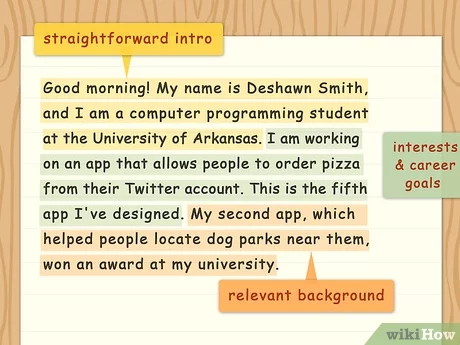
How to Write a Speech About Yourself?
To write a speech about yourself, start by identifying your key accomplishments and experiences in a concise manner and then structure your speech around these points. When it comes to providing a speech about oneself, it’s crucial to strike a balance between confidently highlighting your achievements and maintaining humility.
Crafting a compelling speech can be challenging, but with a clear structure and effective storytelling, you can effectively convey your personal narrative. This article offers practical tips and insights to help you write a speech about yourself that captivates your audience’s attention and leaves a lasting impression.
Whether you’re preparing for a graduation ceremony, job interview, or a personal event, this guide will ensure your speech is well-organized, engaging and highlights the unique aspects that define you. Let’s delve into the process of writing an impactful speech about yourself.
Table of Contents
2. Crafting Your Personal Story
Crafting Your Personal Story is a crucial aspect of writing a speech about yourself. Through this process, you can effectively highlight your unique experiences, skills, and achievements, capturing the audience’s attention and making a lasting impression.
- Introduction: Start with a captivating opening that grabs your audience’s attention. Introduce yourself briefly and state the purpose of your speech.
- Main Body: Divide your speech into sections or paragraphs, with each focusing on a specific key experience. Start by providing some context for each experience, and then share the details of what happened, including any challenges or lessons learned.
- Transition: Use transitional phrases or sentences to smoothly move from one experience to the next. This will help create a logical flow and maintain the interest of your audience.
- Conclusion: Summarize your key experiences and tie them back to the theme of your speech. Leave your audience with a memorable closing statement or call to action.

Credit: www.wikihow.com
3. Engaging With Your Audience
When delivering a speech about yourself, it’s crucial to engage your audience to capture their attention and make a lasting impression. By establishing a connection, relating to their experiences, and incorporating humor, you can create a memorable and impactful speech.
3.1 Establishing Connection
Establishing a connection with your audience is fundamental to building rapport and keeping them engaged throughout your speech. You can achieve this by:
- Maintaining eye contact to make your audience feel involved and connected to your story.
- Mirroring their body language subtly to create a sense of familiarity and rapport.
- Using inclusive language such as “we” and “us” to establish a shared experience.
3.2 Relating To Their Experiences
Relating to your audience’s experiences helps them connect your story to their own lives, making it more relatable and engaging. Consider:
- Sharing personal anecdotes that your audience can resonate with and find common ground.
- Using examples and analogies that illustrate situations similar to the ones your audience may have encountered.
- Addressing universal struggles or aspirations that your audience can relate to emotionally.
3.3 Using Humor
Integrating humor into your speech not only entertains your audience but also helps them remember your message. Here’s how:
Remember, striking a balance between relatability and humor is key. Make sure the jokes or anecdotes you use are appropriate for the occasion and align with the overall tone of your speech.
Engaging with your audience during a speech about yourself not only captures their attention but also builds a connection and leaves a lasting impact. By establishing rapport, relating to their experiences, and incorporating humor, you can ensure your speech resonates with your audience and creates a memorable experience.
4. Showcasing Your Achievements
Crafting a speech about yourself requires showcasing your achievements effectively. Highlight your accomplishments in a concise and engaging way to captivate your audience. Let your successes shine while staying authentic in delivering your story.
4.1 Highlighting Accomplishments
- Make a list of your top achievements.
- Categorize them based on their relevance to your speech.
- Select the most impressive and impactful achievements to include in your speech.
- Describe each accomplishment briefly, focusing on the challenges you faced and the results you achieved.
- Use specific examples, numbers, or metrics to quantify the success.
4.2 Demonstrating Expertise
- Clearly state your qualifications and relevant experience at the beginning of your speech.
- Provide examples of how your expertise has been applied in real-world situations.
- Share success stories or case studies to illustrate your problem-solving abilities.
- Highlight any certifications, degrees, or training that reinforce your expertise in the topic.
- Show enthusiasm and passion for the subject matter to further establish your credibility.
4.3 Imparting Lessons Learned
- Reflect on your experiences and identify valuable insights or key learnings.
- Craft concise and impactful statements that encapsulate each lesson.
- Explain how these lessons have influenced your growth and success.
- Relate the lessons to the audience’s context to increase relevance and engagement.
- Encourage your audience to reflect on their own experiences and apply the lessons to their own lives.

Credit: www.pinterest.com
5. Ending With Impact
Learn how to write a speech about yourself that leaves a lasting impact with these effective tips. Craft your sentences to be concise, captivating, and memorable, ensuring your audience is engaged from start to finish.
5.1 Call-to-action
- Clearly state what you want the audience to do.
- Make it specific and achievable.
- Highlight the benefits they will gain.
5.2 Summarizing Key Points
- Start by briefly restating your main message or thesis statement.
- Highlight the main supporting points you covered throughout your speech.
- Reinforce the significance and relevance of your main ideas.
5.3 Leaving A Lasting Impression
- End with a powerful quote or thought-provoking statement that encapsulates your speech.
- Share a personal anecdote that leaves a strong emotional impact.
- Reiterate your main message, emphasizing its significance.

Frequently Asked Questions On How To Write A Speech About Yourself?
How do i start a speech about myself.
To start a speech about yourself, introduce yourself with a brief personal background and highlight your expertise or achievements that are relevant to the topic of the speech.
What Are Some Tips To Engage The Audience In A Speech About Myself?
Engage the audience in your speech about yourself by using storytelling, incorporating humor, asking thought-provoking questions, and maintaining eye contact to create a connection.
How Can I Make My Speech About Myself Memorable?
Make your speech about yourself memorable by sharing personal anecdotes, using visuals or props, expressing passion and emotion, and ending with a strong and inspiring conclusion.
Writing a speech about yourself can be a daunting task, but it is also an opportunity to showcase your unique qualities and experiences. By following the steps outlined in this blog post, you can create an engaging and impactful speech that will captivate your audience.
Remember to be authentic, speak from the heart, and use storytelling techniques to connect with your listeners. With practice and confidence, you will be able to deliver a speech that reflects who you truly are. Good luck!
Similar Posts
How do i learn public speaking without attending a public speaking class.
To learn public speaking without attending a class, you can practice through online resources and join public speaking clubs. Public speaking is a valuable skill that can be developed outside of a formal classroom setting. Online platforms offer a variety of courses, tutorials, and videos that can provide guidance and techniques for improving your public…

10 Tips on How to Become a Better Storyteller?
To become a better storyteller, implement these 10 tips: practice regularly, create compelling characters, use vivid descriptions, establish a clear structure, engage emotions, experiment with different perspectives, incorporate dialogue, vary your pacing, seek feedback, and embrace vulnerability. Storytelling is an ancient art form that allows us to connect with others, share our experiences, and elicit…

Anxiety Medication in Public Speaking
Anxiety medication can help with public speaking by reducing symptoms and promoting a sense of calmness. Public speaking can often trigger anxiety and nervousness, making it difficult for individuals to present their ideas effectively. Anxiety medication can help by reducing the physical symptoms associated with anxiety, such as rapid heartbeat and sweating, which can interfere…

What Does Resolved Mean in Debate?
Resolved means to reach a decision or find a solution in a debate. In a debate, the term “resolved” refers to the proposition or statement that is being discussed and debated upon by the participants. It is the central topic or issue that is being disputed and requires a resolution or conclusion to be reached…
How to Find a Good Public Speaking Topic?
To find a good public speaking topic, brainstorm ideas based on your interests, expertise, or current events. Then, narrow down your choices to select a subject that is relevant, engaging, and unique for your audience. What Makes A Good Public Speaking Topic Searching for a good public speaking topic can be quite daunting, but it…
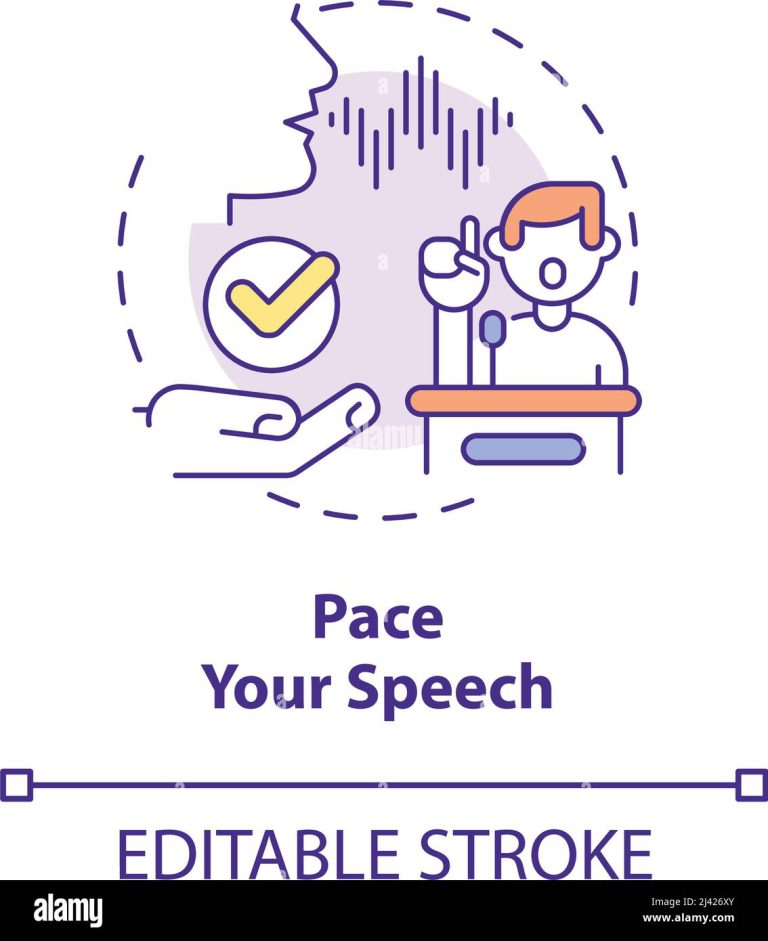
How to Pace Your Speech?
Pacing your speech involves speaking at a consistent and appropriate speed, which can be achieved through practice and awareness of your audience’s needs. When delivering a speech, it is important to maintain a suitable pace to ensure that your message is effectively communicated to your audience. Speaking too fast can result in the information being…
How to Write a Speech About Yourself

Use this extensive guide to learn everything that you need to know about giving speeches. Nobody has to be born with an overwhelming amount of confidence and charisma to be good at speeches, even if that helps a lot.
Moreover, to deliver a great speech, you’ll need to come prepared with the written version of it. So, there’s no skipping this step. After that, it’s just practicing until it feels right. With the knowledge we will provide in this article, you can become more confident and skilled at speech writing.
We will also provide persuasive speech examples for you to have a clear reference for what you can write, so there’s no need to fret. Let’s go through this step by step with our write my dissertation service .
What We’ll Cover
Don’t skip anything in this article if you want to make a stellar self-introduction speech about yourself that delivers your message and leaves an impact on your audience. The impact that you want, of course.
On a side note, if you’re looking for expert writing help via the web, then EssayPro is a paper writing service with hundreds of expert writers ready for your beck and call.
Moving on, this article will help you with:
- Making a speech outline
- To learn what to say about yourself
- Writing a 2-minute speech
- Writing persuasive speeches
- Learning how to write in the correct tone, as well as learning how to create an interesting hook
This info will be very useful if you want to create a well-written self-introduction speech about yourself. '
What Is an Introductory Speech?
An introductory speech is a speech talking about yourself and particular aspects of yourself to persuade a crowd or perhaps reach a certain goal. Too burnt out? If you need a writer to help you make a speech, then you should consider outsourcing some of the writing to a professional.
But if you decide to take on the challenge of writing a self-introduction speech, after all, you should remember that the point of it is to communicate who you are to your audience first and foremost.
Start With an Outline
Preparation is key when writing an introductory speech. As an example, we’ve given you an entire speech outline that focuses on personal achievements at work and school. Of course, the content of your speech can change depending on the context. But the basic structure stays the same. Here it is:
Introduction. In the intro, state any fundamental information about you. This includes your full name, faculty, expertise, and college/university if you are attending one. Use a hook to get your audience invested in what you have to say.
Informative Body Part . If the goal is to persuade and present oneself in a good light through personal achievements, then the body part should be as straightforward as possible. You can start by talking about:
- Personal experiences and achievements
- Professional experience, work life, and professional achievements, your expertise, and specialty
- Social activities like volunteering, community work, charities, etc.
- Your educational background
Bonus Information. Include info on your skills, hobbies, and any additional languages you might speak.
Conclusion. You can write about future goals, dreams, and ambitions here.
You are slowly learning how to write a speech about yourself the right way. Keep reading.
What You Can Write About Yourself in a Speech
When writing and delivering an engaging ‘all about me’ speech, you can consider including the following (if it’s context-appropriate):
- Telling a personal story about your life and experiences
- Using quotes that motivate and inspire. Only use quotes that have a significant meaning to you
- Asking questions to further engage the audience
Speeches are similar to rhetorical analysis, so you might learn a thing or two from reading up on them. Moreover, there is no one way to answer the question ‘how to write a persuasive speech’, but you can interject these elements in between information about yourself to keep it dynamic.
Writing a Two Minute Speech About Yourself
If you want to write a 2-minute speech about yourself, then it’s important to write about what matters since time is so limited. If you want to freshen up your writing, review types of sentences for a memory boost. But don’t stretch yourself too thin.
Let’s look at an example of how to write a speech. Let’s say you’re writing a speech for a job opportunity. Here are some things you can keep in mind but can also be applied to other contexts:
- Mention your current job and your educational background, and don’t forget to talk about your dreams and goals.
- Get into detail. Mention what you did in your job and your professional achievements. Don’t be vague. You want to radiate confidence and provide concrete information.
- Talk with enthusiasm . Charisma can sometimes be seen from a mile. Do you think a recruiter would hire a monotonous and overly hesitant speaker over someone charismatic, precise, and enthusiastic?
Do you know anything about the case study format ? If not, we urge you to read our blog article.
Need some help with a speech about yourself?
To buy speech simply send us your speech topic and requirements, choose a writer and we’ll get it done.
Persuasive Speech Outline
An introductory speech could also be persuasive, especially if you’re trying to get the audience to agree with your point of view. That’s the essence of a persuasive speech - to persuade. If you’re confused, start with a persuasive speech outline of the course. It could resemble this:
- Introduction : Include a hook, information about the topic, and perspective that you want to talk about, and then hit the audience with your thesis/claim.
- Body : Extrapolate on the points you made in the intro, just like in an essay. Start with the main ideas, then follow up with evidence.
- Conclusion : Restate the main idea/claim of your choosing. Restate your arguments, then write why you think your arguments are positive and have value. Then, depending on the context, call the audience to action.
And that basically answers the question of ‘How to write a speech outline for persuading?’. If you need some inspiration material - you can look up any TED talk. You’ll see that they tend to follow this structure pretty often.
Check out some narrative writing topics , the information may be helpful to you.
Persuasive Speech About Yourself
Speaking of persuasive speech examples, let’s look at an example of how to write a speech. If you need more references, then use ours below to refine your writing. It’s good to look at references since it can easily help you with any individual blocks in your creative process.
Persuasive Speech Example
Persuasive speech for a business presentation, step by step tips.

We’ve come this far in answering the questions of ‘How to write a speech about yourself?’, and for those who are still confused - it’s okay. We’re going to break it down for you, simple and clear. Follow our step-by-step guide, and you’ll overcome hurdles while writing what you need to.
And on that note, for any writing difficulties you may have, the college essay writing service is ready and accessible through the click of your mouse. If your burdens are piling up, it’s time to get a helping hand.
Now let’s go through our guide to help you learn how to start a speech about yourself and how to end a speech about yourself.
Tone of Voice
Let’s not forget to cater the language and tone of your speech to the context and audience. We’ve learned that in speeches for a change in education or career opportunities, it’s best to keep a professional tone of voice and highlight your achievements.
However, if the introductory speech is for a toast, or perhaps to persuade a general audience, a more relatable tone of voice is acceptable.
Write a Hook
A hook should be intriguing, attention-grabbing, strong, and catchy. Its goal is to capture an audience, so try to think of something that subverts the audience’s expectations. For example, if your speech is going to be about yourself, don’t start with, “My name is Jeff.” Start things with something like, “I’ve always wanted to speak in front of an audience and share what’s important to me, and here I am now.”
Any speech class deals with this part of a self introduction speech in great detail. It will help you capture the audience’s attention. And once you have that - you are pretty much golden. Any speech is about capturing the audience’s attention first and foremost.
Make an Outline
As we’ve stated time and again, an introduction speech about yourself should be written after you’ve made a solid outline. Outlines streamline the process of making the speech and can help clear out any brain fog as well as give you a sense of direction.
Write Your Speech
Now that you’ve got an outline, it’s time to take all the pieces together and write them down. And just like that, you’re halfway there already. By following what you’ve learned in the whole article, the writing part should have been made easier. Take the time to write your speech, edit it, and then it’s on to the next. Stick around to see an example of how to write a persuasive speech example.
Start with a short speech at first. A couple of sentences will be more than enough. You can then work your way up, adding some fluff to the opening statement, mentioning your professional life, and utilizing bullet points to make a stronger impression. Just be sure not to lose your main point, provide only relevant information without too much derailing, and use simple sentences to make a stronger impression.
You can also use some minimal prompts to push you in the right direction. Your first rough draft should not be perfect. But as you move forward, it should be getting better and better with every revision up until you arrive at your final draft. Introductory speeches require a lot of detailed feedback to polish. Run your draft by your friends, and see what they can help you with. This is going to be a turning point in your writing process. Public speakers are used to rehearsing their speeches multiple times in advance.
Practice It!
It’s crunch time. All the effort, preparing, writing, and researching ideas come down to this point. While there are individuals who are great at improvising, don’t take a chance if you’ve never given a speech before. It’s best to be prepared. Being prepared can help you gain confidence in what you’re saying. Even if you’re not very good at public speaking - this is how you make it work.
If you have enough time, you can even take a speech class. It will help you be more confident about your public speaking. Giving some smaller speeches could also help you improve your public speaking skills. A self-introduction speech is not really that hard. And public speaking is not a talent, it’s an acquired skill. So work on improving it.
If you’re still looking for ideas, then here are some about me speech ideas that can help and might still give you some more insight on how to write a good speech about yourself.
Don't forget that we provide coursework, research, nursing paper writing services . You can turn to us for any help.
Do You Need Some Help With Your persuasive essay?
Count on the support of our professional writers and editors.We process all ' write an essay for me ' requests fast.

Daniel Parker
is a seasoned educational writer focusing on scholarship guidance, research papers, and various forms of academic essays including reflective and narrative essays. His expertise also extends to detailed case studies. A scholar with a background in English Literature and Education, Daniel’s work on EssayPro blog aims to support students in achieving academic excellence and securing scholarships. His hobbies include reading classic literature and participating in academic forums.

is an expert in nursing and healthcare, with a strong background in history, law, and literature. Holding advanced degrees in nursing and public health, his analytical approach and comprehensive knowledge help students navigate complex topics. On EssayPro blog, Adam provides insightful articles on everything from historical analysis to the intricacies of healthcare policies. In his downtime, he enjoys historical documentaries and volunteering at local clinics.
Related Articles
.webp)

How it works
Transform your enterprise with the scalable mindsets, skills, & behavior change that drive performance.
Explore how BetterUp connects to your core business systems.
We pair AI with the latest in human-centered coaching to drive powerful, lasting learning and behavior change.
Build leaders that accelerate team performance and engagement.
Unlock performance potential at scale with AI-powered curated growth journeys.
Build resilience, well-being and agility to drive performance across your entire enterprise.
Transform your business, starting with your sales leaders.
Unlock business impact from the top with executive coaching.
Foster a culture of inclusion and belonging.
Accelerate the performance and potential of your agencies and employees.
See how innovative organizations use BetterUp to build a thriving workforce.
Discover how BetterUp measurably impacts key business outcomes for organizations like yours.
A demo is the first step to transforming your business. Meet with us to develop a plan for attaining your goals.

- What is coaching?
Learn how 1:1 coaching works, who its for, and if it's right for you.
Accelerate your personal and professional growth with the expert guidance of a BetterUp Coach.
Types of Coaching
Navigate career transitions, accelerate your professional growth, and achieve your career goals with expert coaching.
Enhance your communication skills for better personal and professional relationships, with tailored coaching that focuses on your needs.
Find balance, resilience, and well-being in all areas of your life with holistic coaching designed to empower you.
Discover your perfect match : Take our 5-minute assessment and let us pair you with one of our top Coaches tailored just for you.

Research, expert insights, and resources to develop courageous leaders within your organization.
Best practices, research, and tools to fuel individual and business growth.
View on-demand BetterUp events and learn about upcoming live discussions.
The latest insights and ideas for building a high-performing workplace.
- BetterUp Briefing
The online magazine that helps you understand tomorrow's workforce trends, today.
Innovative research featured in peer-reviewed journals, press, and more.
Founded in 2022 to deepen the understanding of the intersection of well-being, purpose, and performance
We're on a mission to help everyone live with clarity, purpose, and passion.
Join us and create impactful change.
Read the buzz about BetterUp.
Meet the leadership that's passionate about empowering your workforce.

For Business
For Individuals
Writing an elevator pitch about yourself: a how-to plus tips

Jump to section
Why write an elevator pitch?
When to give an elevator pitch about yourself, how to write an elevator pitch about yourself: 5 steps.
How to deliver an elevator pitch about yourself
Pitch with confidence
Sometimes, you only have 30 seconds to make yourself stand out.
Whether you’re at a networking event, job interview, or career fair, you need to make a good first impression to gain your audience’s interest. Everyone has their own agenda. You must make the most of their time by providing them with all the information they need to understand who you are and what you offer. That’s where a personal elevator pitch comes in.
An elevator pitch, or elevator speech, is a concise explanation of your professional or personal brand. You write and memorize one you can deliver like a speech when the time is right. It usually lasts less than a minute — or about the time it takes to ride an elevator.
Creating and presenting an elevator pitch about yourself forces you to consider your strengths, describe your skills with brevity, and remember why you’re an asset.
Even though it’s a small sample size of you and your ideas, an elevator pitch can leave a lasting impression. It only takes a few milliseconds for someone to judge your character . If you use your time wisely with a well-prepared pitch, you’ll make your mark.
You can also use an elevator pitch to encourage an emotional response from your audience. As Maya Angelou said , “People will forget what you said, people will forget what you did, but people will never forget how you made them feel.”
Psychology backs this up: emotional memories are often more powerful and long-lasting . If your elevator pitch includes a brief anecdote from your childhood that resonates with your audience, for example, they might remember who you are and what you offer long after the interaction.

And because you’re meant to pull out an elevator pitch at a moment’s notice and make it concise, crafting one is a great way to learn to efficiently present your thoughts. Creating one can help you develop your writing, editing, and communication skills , among others. You’ll also develop research skills since you should customize every pitch to your audience or the networking event.
Drafting a personal elevator pitch is also an opportune time to affirm your value. If you experience imposter syndrome , or the feeling that you’re not good enough or prepared as well as you should be, brainstorming what makes you or your product valuable convinces you of this as well.
You can treat drafting, practicing, and delivery as a self-affirmation process that reminds you of your worth. Lastly, writing an elevator pitch is a fantastic time to discover any kinks in your business model. If you’re just starting out with a business idea, you can begin the brainstorming process by jotting down a one-minute speech about your offering.
Then, go off of this information to note any shortfalls, risks, and issues with your idea. This will help you develop a more comprehensive and thoughtful business plan to move forward with.
Some pitch-worthy situations are subtle, like when a professional in your industry starts chatting you up at your kid’s favorite park. Others are more obvious, like in an interview when asked , “Tell me about yourself.”
Here are some more settings that are perfect for delivering a pitch about yourself:
- Networking events : The purpose of networking opportunities is to connect with like-minded professionals. Use these events to broaden your circle and share your offering with as many people as possible.
- Job interviews: Typically right at the start, a recruiter or hiring manager will ask you to briefly describe yourself and your career up to that point. They usually want more than a reminder of your cover letter and resume , instead hoping to gain a well-rounded summary of your work ethic , personality, and employee strengths .
- LinkedIn professional summary and messages: Your professional social media presence speaks volumes about who you are and what you’re capable of. Make your LinkedIn profile reflect your offering and differentiators to increase the chance viewers consider you for opportunities.
- Career fairs: A career fair tests your ability to carry small talk and practice your elevator pitch. If you’re trying to land a job, you might consider creating a networking plan to execute at a job fair. To take some pressure off, remember that employers want you to be the one — they're looking for a good match for their organization and hope every person they encounter is it.
- Reunions: Be it a “Class of '09” school get together or a professional dinner for previous colleagues, reunions can be valuable networking opportunities in disguise. You never know what industry your high school best mate ended up in — and whether he might have the resources necessary to help you climb the corporate ladder of your choosing.

Your elevator pitch should be straight to the point, error-free, and compelling enough that they remember you. After reading or hearing about your expertise and offering, they should know precisely the opportunities they ought to keep you in mind for.
Follow these five steps to craft your personal proposal.
1. Explain who you are
Start by introducing yourself — your name and current profession. Then find a couple key explanatory words to describe yourself further, perhaps altering your word choices to your audience.
If you’re a graphic designer, you might say, “Hey, I’m [name], a graphic designer focusing on search-engine-optimized websites. But really, I love any project that gets the creative juices flowing.” The listener now knows your name, what you do, your specialty, and that you’re a creative individual who might take on any fun project that comes your way.
2. Explain what you want
Next, get to the point of what you want. If you’re looking for funding for your startup, say so — right off the bat. People appreciate transparency , so being honest puts you in a good light right away. You also can only gain what you ask for, and mentioning your needs immediately ensures you share this information before they lose interest.
3. Explain what makes you unique
Your unique selling point depends on what you’re selling and could be anything from a great accomplishment, unique product feature you worked to create, or an interesting hobby.
If you’re trying to make a good impression on a coworker, you might express interest in an activity you know they enjoy. And if you’re pitching yourself to a hiring manager, you might note an employee strength that perfectly suits a role they’re hiring for.

4. Create a call to action (CTA)
A CTA is an action you prompt the reader or listener to take after an interaction. When an email ends with a “Sign up for our newsletter!” button, that’s a CTA.
In most situations, the best elevator pitches end with a CTA to keep the momentum going and spur engagement from your audience. You might direct them to check out your website or look at a demo you’ve sent. Or you might simply leave them with your contact information, like on a business card, and extend the offer for them to reach out. And you can let them know you’ll follow up to show your proactivity and care.
But sometimes, like in a job interview, you won’t close a pitch with a CTA. Instead, you can simply leave them on the intriguing note of your unique differentiator.
5. Edit what you’ve written
Editing helps you condense information and ensure only the most important bits remain. Grammar and spelling errors also seem unprofessional so you can make a better impression if your work is error-free.
If your pitch is verbal, you can still edit the content you memorize, reading it aloud several times to catch sticky areas or confusing sentences.
How to deliver an elevator pitch about yourself
As Malcolm Gladwell argued, it takes 10,000 hours to perfect any craft . You likely won’t require this much time to write and memorize a great elevator pitch, but practice helps. You’ll feel more confident and comfortable knowing you won’t forget any details.
Here are five tips to help you deliver a fantastic personal pitch.
1. Speak naturally and articulately
For verbal pitches, your delivery is just as important as its content. You don’t want to sound like a pushy salesperson — even though you’re selling yourself. And you want them to understand your words well so they catch important information.
If you animate some of the highlights of your speech by adjusting your intonation or adding emotion, they might retain this information more because you’ve increased their engagement.
When deciding how to deliver a pitch, work on cultivating welcoming body language but respecting their personal space. You should also make eye contact to keep them listening and try to convey a calm and relaxed demeanor to show them your confidence .

2. Tweak your pitches
Make your pitch more effective by customizing it to your audience. This builds rapport and shows you respect their time and aren’t simply delivering a generic speech. Instead, you’ve taken the time to research who they are, their interests, and how you might fit into their plans.
If delivering this pitch during a job interview, use language from the job description to show you’re a great fit. And if introducing yourself at a networking event, include industry-specific achievements those around you might care about.
3. Take it slow
While you have a lot you want to say in 30–60 seconds, don’t rush through your pitch. This makes it difficult for the listener to catch important details (like what you do or offer) and makes you seem nervous. You also want them to become engaged in your pitch — asking questions is the best outcome because this means the conversation can continue and you can provide even more information.
Slowing down requires practice. Deliver your speech to a trusted friend or coworker and ask for feedback about your speed. Once they approve of a certain pace, figure out how long it takes for you to deliver it that way and practice always reaching that allotted time.
You can also practice breathing exercises to train yourself to deliver comfortably. Your vocal power, tone, and pace are all connected to your ability to control your breathing and, therefore, your pulse . Breathing exercises also help control anxiety (the jitters) and allow you to focus on what matters — making a good impression.
4. Engage with a question
Ending your speech with a question is a fantastic way to keep the conversation going and show interest in your audience instead of just talking about yourself. You might ask a hiring manager if they could tell you more about the company’s origin story, for example, or a fellow industry professional about what their career path has looked like thus far.
5. Avoid rambling
You’ll typically ramble if you’re nervous or your thoughts are disorganized, and this is especially likely if you haven’t practiced your pitch and feel put on the spot. But rambling means you’ve lost the story’s point — and so will your audience. You’ll likely focus on unimportant details, missing the highlights you need your listener to remember.
The best way to avoid rambling is to practice your pitch. And if you expect you’ll need to sell yourself on the spot in situations where you can’t prepare, like a large networking event, you can memorize several key points about yourself to make conversing easier.
If you notice yourself rambling, don’t fret — simply return to your point to strengthen this habit and with time, you’ll rarely lose your train of thought.
Expressing who you are and what you offer can be difficult, but doing so reminds you of your worth and ensures others understand the solutions you provide.
When presenting your personal brand, make sure the elevator pitch about yourself is snappy, informative, and memorable. You’ve got a 30-second elevator ride — and hopefully tons of practice — to get your point across.
If possible, rehearse several versions of your speech so you’re prepared for every occasion. You’ll know how to effectively sell yourself to the interested hiring manager and the distracted investor. And you’ll have gained priceless professional growth , like researching your audience and adjusting your body language and tone of voice to the situation.
Transform your life
Make meaningful changes and become the best version of yourself. BetterUp's professional Coaches are here to support your personal growth journey.
Madeline Miles
Madeline is a writer, communicator, and storyteller who is passionate about using words to help drive positive change. She holds a bachelor's in English Creative Writing and Communication Studies and lives in Denver, Colorado. In her spare time, she's usually somewhere outside (preferably in the mountains) — and enjoys poetry and fiction.
Make the connection: 10 effective ways to connect with people
How to be more persuasive: 6 tips for convincing others, thinking outside the box: 8 ways to become a creative problem solver, how to answer 8 phone interview questions to ace your interview, 8 examples for setting professional development goals at work, is personal time off paid how to navigate employer pto plans, how to use power (of your position and your person) in the workplace, how to deal with difficult coworkers: 5 tips for a friendlier workplace, 10 examples of principles that can guide your approach to work, similar articles, 10 personal brand statements to put all eyes on you, learn how to introduce yourself in conversation and in writing, how to write a speech that your audience remembers, the importance of good speech: 5 tips to be more articulate, how to pitch ideas: 8 tips to captivate any audience, how to introduce yourself in an interview: examples & tips, 8 clever hooks for presentations (with tips), overcome your public speaking anxiety with these 10 tips, 9 elevator pitch examples for making a strong first impression, stay connected with betterup, get our newsletter, event invites, plus product insights and research..
3100 E 5th Street, Suite 350 Austin, TX 78702
- Platform Overview
- Integrations
- Powered by AI
- BetterUp Lead™
- BetterUp Manage™
- BetterUp Care®
- Sales Performance
- Diversity & Inclusion
- Case Studies
- Why BetterUp?
- About Coaching
- Find your Coach
- Career Coaching
- Communication Coaching
- Life Coaching
- News and Press
- Leadership Team
- Become a BetterUp Coach
- BetterUp Labs
- Center for Purpose & Performance
- Leadership Training
- Business Coaching
- Contact Support
- Contact Sales
- Privacy Policy
- Acceptable Use Policy
- Trust & Security
- Cookie Preferences
My Speech Class
Public Speaking Tips & Speech Topics
Self Introduction Speech [Topics + Outline Sample]

Jim Peterson has over 20 years experience on speech writing. He wrote over 300 free speech topic ideas and how-to guides for any kind of public speaking and speech writing assignments at My Speech Class.

This page deals with self introduction speech topics for classroom or other public speaking events an opportunities in life for a good first impression.
In this article:
Sample Introduction Speech Topics
Sample self introduction speech outline.
Another short manner for introducing yourself is the elevator speech, meant for business purposes.
The key question for successful and effective presenting yourself to others in both occasions is: how much and what information do you want the audience to know about you?
Due to the fact you have to write your talk around one theme, I recommend to develop one aspect of your life. That aspect will tell who you are and what you are about. Some people call this type a one-point preliminary, because it is based on one speaking idea.
Can We Write Your Speech?
Get your audience blown away with help from a professional speechwriter. Free proofreading and copy-editing included.
Look at the sample self introduction speech topics and pick out the aspects of your personal life you want to share with the audience. Approach the list below with the who, the what, the whereabouts, for sure the why, the how and when questions. That is an effective way to outline your first thoughts.
- What activity has played or plays an important part in your life? Tell the story and distract the message.
- What is your main personal goal?
- What do you like very much? Your hobby?
- What do you hate or dislike? Your aversions?
- Do you have developed a very special skill?
- What is your lifestyle?
- Can you come up with a turning point or milestone in you life?
- What is your hobby or interest in your spare time?
- What is a pet peeve or another very familiar topic you like to talk about, to do or to discuss?
- Where you are from? Do your roots reveal something about yourself that is new for the audience? That always works in a small nice text for introducing your biggest personal features.
- Is there an object or prop that means a lot to you?
- What distinguishes you from other individuals in class?
Now that you have picked out a central thesis, use this example profiler I have created:
Grab their attention . Immediately bring in your central message and come to the point.
Give some background information . Tell why it is important to you, why you are doing it, why you want to tell them, etcetera.
Now work out your item of discussion in a few sentences. Draw the contours, make it personal.
Give an example .
In conclusion, offer a memorable answer in your self-introduction speech on the question the listeners probably will have when they listen to your public speaking efforts: what’s in it for me? Tell how this aspect of your life makes who you are and what you are. It will be the perfect ending of your spoken presentation.
113 Extemporaneous Speech Topics
147 Unique Speech Topics [Persuasive, Informative]
2 thoughts on “Self Introduction Speech [Topics + Outline Sample]”
i think that talking about some people that have influenced you the most really gives good base to your speech and it helps you by writing about things that you are familiar with so if you write about what has inspired you and what you care about you can easily write about anything.
Domestic violence
Leave a Comment
I accept the Privacy Policy
Reach out to us for sponsorship opportunities
Vivamus integer non suscipit taciti mus etiam at primis tempor sagittis euismod libero facilisi.
© 2024 My Speech Class

Effective Self-Introductions (Inspiring Examples and Scripts)
By Status.net Editorial Team on September 22, 2023 — 21 minutes to read
- Structure of a Good Self-introduction Part 1
- Examples of Self Introductions in a Job Interview Part 2
- Examples of Self Introductions in a Meeting Part 3
- Examples of Casual Self-Introductions in Group Settings Part 4
- Examples of Self-Introductions on the First Day of Work Part 5
- Examples of Good Self Introductions in a Social Setting Part 6
- Examples of Good Self Introductions on Social Media Part 7
- Self-Introductions in a Public Speaking Scenario Part 8
- Name-Role-Achievements Method Template and Examples Part 9
- Past-Present-Future Method Template and Examples Part 10
- Job Application Self-Introduction Email Example Part 11
- Networking Event Self-Introduction Email Example Part 12
- Conference Self-Introduction Email Example Part 13
- Freelance Work Self-Introduction Email Example Part 14
- New Job or Position Self-Introduction Email Example Part 15
Whether you’re navigating a job interview, networking event, or simply meeting new people, the way you introduce yourself sets the tone for the entire interaction. In this comprehensive guide, we’ll equip you with the essential tools and techniques to confidently and effectively introduce yourself in any situation, leaving a lasting and positive impression.
Part 1 Structure of a Good Self-introduction
- 1. Greeting and introduction: Start by greeting the person you’re speaking to and introducing yourself. For example, “Hi, my name is Jane. Nice to meet you!”
- 2. Brief personal background: Give a brief overview of your personal background, such as where you’re from or what you do. For example, “I’m originally from California, but I moved to New York a few years ago. I work in marketing for a tech company.” Related: 10 Smart Answers: “Tell Me About Yourself”
- 3. Professional experience: Highlight your relevant professional experience, including your current or previous job titles and any notable achievements. For example, “I’ve been working in marketing for about 5 years now, and I’m currently a Senior Marketing Manager at my company. Last year, I led a successful campaign that resulted in a 20% increase in sales.” Related: How to Describe Yourself (Best Examples for Job Interviews)
- 4. Skills and strengths: Mention any skills or strengths that are relevant to the conversation or the situation you’re in. For example, “I’m really passionate about data analysis and using insights to inform marketing strategy. I’m also a strong communicator and enjoy collaborating with cross-functional teams.” Related: 195 Positive Words to Describe Yourself [with Examples] 35 Smart Answers to “What Are Your Strengths?” What Are Your Strengths And Weaknesses? (Answers & Strategies)
- 5. Personal interests: Wrap up your self-introduction by mentioning a few personal interests or hobbies, which can help to humanize you and make you more relatable. For example, “In my free time, I love hiking and exploring new trails. I’m also a big fan of trying out new restaurants and cooking at home.”
- Related: Core Values List: 150+ Awesome Examples of Personal Values Best Examples of “Fun Facts About Me” What Are Your Values? How to Discover Your Values
Part 2 Examples of Good Self Introductions in a Job Interview
When introducing yourself in an interview, you should be confident, clear, and knowledgeable. Maintain eye contact, speak with a steady tone, and be concise. Prepare your introduction beforehand to avoid stumbling or getting too wordy. Try to cover these aspects:
- Current or most recent position/job
- A relevant accomplishment or strength
- Why you are excited about the company or role

Templates and Scripts
“Hello, my name is [Your Name], and I recently worked as a [Your Most Recent Position] at [Company/Organization]. I successfully managed a team of [Number] members, achieving a [Relevant Accomplishment or Growth]. I’m excited about the opportunity at [Interviewer’s Company] because [Reason Why You’re Interested].”
“Hi, I’m [Your Name], a [Current Job Title or Major Accomplishment]. I’m passionate about [Relevant Industry or Skillset] and have a proven track record of [Specific Result or Achievement]. I believe my skills and experience make me well-suited for this role at [Company], and I’m excited to explore how I can contribute to [Company Goal or Project].”
“Hi, my name is Jane Doe, and I’m the Assistant Marketing Manager at ABC Corp. I recently implemented a successful social media campaign, which increased engagement by 30%. I’m thrilled about the possibility of working with XYZ Inc. because of your innovative marketing strategies.”
“Hello, I’m John Smith, a financial analyst with five years of experience in the banking industry. I’ve consistently exceeded sales targets and helped my team win an award for excellent customer service. I’m excited to join DEF Ltd. because of your focus on sustainable and responsible investing.”
Remember to tailor your introduction to the specific interview situation and always show enthusiasm for the position and company. This will show the interviewer that you are the right fit.
Related: How to Describe Yourself (Best Examples for Job Interviews)
Part 3 Examples of Good Self Introductions in a Meeting
General tips.
When introducing yourself in a meeting, consider these tips:
- Start with a greeting: Begin with a simple “hello” or “good morning.”
- State your name clearly: Don’t assume everyone knows you already.
- Mention your role in the company: Help others understand your position.
- Share relevant experience or accomplishments: Give context to your expertise.
- Be brief: Save detailed explanations for later conversations.
- Show enthusiasm: Display interest in the meeting and its objectives.
- Welcome others: Encourage a sense of connection and camaraderie.
Here are some templates and scripts to use when introducing yourself in a meeting:
- Basic introduction : Hi, I’m [Name], and I work as a [Your Role] in the [Department]. It’s great to meet you all.
- Involvement-focused : Good morning, everyone. I’m [Name], [Your Role]. I handle [Responsibility] in our team, and I’m looking forward to working with you on [Project].
- Experience-based : Hello! My name is [Name] and I’m the [Your Role] here. I’ve [Number of Years] of experience in [Skills or Industry], so I hope to contribute to our discussions during the meeting.
Here are some examples of self-introductions in different scenarios:
- New team member : Hi, I’m [Name]. I just joined the [Department] team as the new [Your Role]. I have a background in [Relevant Experience] and am excited to start working with you on our projects!
- External consultant : Hello everyone, my name is [Name], and I’m here in my capacity as a [Your Role] with [Your Company]. I specialize in [Skill or Industry], and I’m looking forward to partnering with your team to achieve our goals.
- Guest speaker : Good morning, I’m [Name], a [Your Position] at [Organization]. I have expertise in [Subject], and I’m honored to be here today to share my insights with you.
Related: 10 Smart Answers: “Tell Me About Yourself”
Part 4 Examples of Casual Self-Introductions in Group Settings
Template 1:.
“Hi, I’m [your name], and I’m a [profession or role]. I love [personal hobby or interest].”
“Hi, I’m Emily, and I’m a pediatric nurse. I love gardening and spending my weekends tending to my colorful flower beds.”
“Hello, I’m Mark, and I work as a data analyst. I love reading science fiction novels and discussing the intricacies of the stories with fellow book enthusiasts.”
“Hey there, I’m Jessica, and I’m a chef. I have a passion for traveling and trying new cuisines from around the world, which complements my profession perfectly.”
Template 2:
“Hey everyone, my name is [your name]. I work as a [profession or role], and when I’m not doing that, I enjoy [activity].”
“Hey everyone, my name is Alex. I work as a marketing manager, and when I’m not doing that, I enjoy hiking in the wilderness and capturing the beauty of nature with my camera.”
“Hello, I’m Michael. I work as a software developer, and when I’m not coding, I enjoy playing chess competitively and participating in local tournaments.”
“Hi there, I’m Sarah. I work as a veterinarian, and when I’m not taking care of animals, I enjoy painting landscapes and creating art inspired by my love for wildlife.”
“Hi there! I’m [your name]. I’m currently working as a [profession or role], and I have a passion for [hobby or interest].”
“Hi there! I’m Rachel. I’m currently working as a social worker, and I have a passion for advocating for mental health awareness and supporting individuals on their journeys to recovery.”
“Hello, I’m David. I’m currently working as a financial analyst, and I have a passion for volunteering at local animal shelters and helping rescue animals find their forever homes.”
“Hey, I’m Lisa. I’m currently working as a marine biologist, and I have a passion for scuba diving and exploring the vibrant underwater ecosystems that our oceans hold.”
Related: 195 Positive Words to Describe Yourself [with Examples]
Part 5 Examples of Good Self-Introductions on the First Day of Work
On your first day of work, it’s crucial to make a good impression with a well-crafted self-introduction. Keep it brief and concise, focusing on your name, role, and background. Make sure to smile, maintain eye contact, and exude confidence. It’s fine to share a little about your personal life, but avoid oversharing.
Here are some templates and scripts to help guide your self-introduction:
- Simple Introduction : “Hi, my name is [Your name], and I’m the new [Your position] here. I recently graduated from [Your university or institution] and am excited to join the team. I’m looking forward to working with you all.”
- Professional Background : “Hello everyone, I’m [Your name]. I’ve joined as the new [Your position]. With my background in [Your skills or experience], I’m eager to contribute to our projects and learn from all of you. Don’t hesitate to reach out if you have any questions.”
- Personal Touch : “Hey there! I’m [Your name], and I’ve recently joined as the new [Your position]. On the personal side, I enjoy [Your hobbies] during my free time. I’m looking forward to getting to know all of you and working together.”
Feel free to tweak these scripts as needed to fit your personality and work environment.
Here are some specific examples of self-introductions on the first day of work:
- Marketing Manager : “Hi, my name is Alex, and I’m excited to be the new Marketing Manager here. I’ve been in the marketing industry for five years and have worked on various campaigns. Outside of work, I love exploring new hiking trails and photography. I can’t wait to collaborate with you all.”
- Software Engineer : “Hello, I’m Priya, your new Software Engineer. I graduated from XYZ University with a degree in computer science and have experience in Python, Java, and web development. In my free time, I enjoy playing the guitar and attending live concerts. I’m eager to contribute to our team’s success and learn from all of you.”
Related: Core Values List: 150+ Awesome Examples of Personal Values
Part 6 Examples of Good Self Introductions in a Social Setting
When introducing yourself in a social setting, it’s crucial to create a positive impression. Keep your body language open and approachable, maintain eye contact, smile, and project confidence. Start with a greeting and follow up with your name. Share something interesting or unique about yourself to engage others in conversation, but avoid oversharing or dominating the conversation. Listen actively and show interest in others, asking questions and seeking common ground.
Here are some templates and scripts to help with your self-introduction in various social settings:
Casual gatherings: “Hi, I’m [Name]. Nice to meet you! I’m a huge fan of [hobby]. How about you, what do you enjoy doing in your free time?”
Networking events: “Hello, I’m [Name] and I work as a [profession] at [company]. I’m excited to learn more about what everyone here does. What brings you here today?”
Parties at a friend’s house: “Hi there, my name is [Name]. I’m a friend of [host’s name] from [work/school/etc]. How do you know [host’s name]?”
Here are some examples of self-introductions in various social settings:
- Casual gathering: “Hey, my name is Jane. Great to meet you! I love exploring new coffee shops around the city. What’s your favorite thing to do on weekends?”
- Networking event: “Hi, I’m John, a website developer at XY Technologies. I’m eager to connect with people in the industry. What’s your field of expertise?”
- Party at a friend’s house: “Hello, I’m Laura. I met our host, Emily, in our college photography club. How did you and Emily become friends?”
Related: Best Examples of “Fun Facts About Me”
Part 7 Examples of Good Self Introductions on Social Media
When introducing yourself on social media, keep it concise, personable, and informative. Showcase your personality while maintaining a professional tone. To stand out, include unique interests or hobbies, and highlight your skills or achievements.
- Keep it brief: Social media is fast-paced, so stick to the essentials and keep your audience engaged.
- Show your personality: Let your audience know who you are beyond your job title or education.
- Include a call-to-action: Encourage your followers to engage with you by asking a question or directing them to your website or other social media profiles.
Template 1: Brief and professional
Hi, I’m [Your Name]. I’m a [Job Title/Field] with a passion for [Interests or Hobbies]. Connect with me to chat about [Subject Matter] or find more of my work at [Website or Social Media Handle].
Template 2: Casual and personal
Hey there! I’m [Your Name] and I love all things [Interest or Hobby]. In my day job, I work as a [Job Title/Field]. Let’s connect and talk about [Shared Interest] or find me on [Other Social Media Platforms]!
Template 3: Skill-focused
Hi, I’m [Your Name], a [Job Title/Field] specializing in [Skills or Expertise]. Excited to network and share insights on [Subject Matter]. Reach out if you need help with [Skill or Topic] or want to discuss [Related Interest]!
Example 1: Brief and professional
Hi, I’m Jane Doe. I’m a Marketing Manager with a passion for photography and blogging. Connect with me to chat about the latest digital marketing trends or find more of my work at jdoephotography.com.
Example 2: Casual and personal
Hey there! I’m John Smith and I love all things coffee and travel. In my day job, I work as a software developer. Let’s connect and talk about adventures or find me on Instagram at @johnsmithontour!
Example 3: Skill-focused
Hi, I’m Lisa Brown, a Graphic Designer specializing in branding and typography. Excited to network and share insights on design. Reach out if you need help with creating visually appealing brand identities or want to discuss minimalistic art!
Part 8 Self-Introductions in a Public Speaking Scenario
When introducing yourself in a public speaking scenario, maintain eye contact, speak clearly, and show enthusiasm. Keep it concise, focusing on your background and what you bring to the table. Stay genuine, along with sharing something relatable or interesting about yourself to form an emotional connection.
- Professional introduction: “Hello, my name is [Your Name], and I have [number of years] of experience working in [your field]. Throughout my career, I have [briefly mention one or two significant accomplishments]. Today, I am excited to share [the main point of your presentation].”
- Casual introduction: “Hey everyone, I’m [Your Name], and I [briefly describe yourself, e.g., your hobbies or interests]. I’m really thrilled to talk to you about [the main point of your presentation]. Let’s dive right into it!”
- Creative introduction: “Imagine [paint a visual with a relevant story]. That’s where my passion began for [the main point of your presentation]. My name is [Your Name], and [mention relevant background/information].”
- Professional introduction: “Hello, my name is Jane Smith, and I have 15 years of experience working in marketing and advertisement. Throughout my career, I have helped companies increase their revenue by up to 50% using creative marketing strategies. Today, I am excited to share my insights in implementing effective social media campaigns.”
- Casual introduction: “Hey everyone, I’m John Doe, and I love hiking and playing the guitar in my free time. I’m really thrilled to talk to you about the impact of music on mental well-being, a topic close to my heart. Let’s dive right into it!”
- Creative introduction: “Imagine standing at the edge of a cliff, looking down at the breathtaking view of nature. That’s where my passion began for landscape photography. My name is Alex Brown, and I’ve been fortunate enough to turn my hobby into a successful career. Today, I’ll share my expertise on capturing stunning images with just a few simple techniques.”
Effective Templates for Self-Introductions
Part 9 name-role-achievements method template and examples.
When introducing yourself, consider using the NAME-ROLE-ACHIEVEMENTS template. Start with your name, then mention the role you’re in, and highlight key achievements or experiences you’d like to share.
“Hello, I’m [Your Name]. I’m currently working as a [Your Current Role/Position] with [Your Current Company/Organization]. Some of my key achievements or experiences include [Highlight 2-3 Achievements or Experiences].”
“Hello, I’m Sarah Johnson. I’m a Senior Software Engineer with over 10 years of experience in the tech industry. Some of my key achievements include leading a cross-functional team to develop a groundbreaking mobile app that garnered over 5 million downloads and receiving the ‘Tech Innovator of the Year’ award in 2020.”
“Hi there, my name is [Your Name]. I serve as a [Your Current Role] at [Your Current Workplace]. In my role, I’ve had the opportunity to [Describe What You Do]. One of my proudest achievements is [Highlight a Significant Achievement].”
“Hi there, my name is David Martinez. I currently serve as the Director of Marketing at XYZ Company. In my role, I’ve successfully executed several high-impact marketing campaigns, resulting in a 30% increase in brand visibility and a 15% boost in revenue last year.”
Template 3:
“Greetings, I’m [Your Name]. I hold the position of [Your Current Role] at [Your Current Company]. With [Number of Years] years of experience in [Your Industry], I’ve had the privilege of [Mention a Notable Experience].”
“Greetings, I’m Emily Anderson. I hold the position of Senior Marketing Manager at BrightStar Solutions. With over 8 years of experience in the technology and marketing industry, I’ve had the privilege of spearheading the launch of our flagship product, which led to a 40% increase in market share within just six months.”
Part 10 Past-Present-Future Method Template and Examples
Another template is the PAST-PRESENT-FUTURE method, where you talk about your past experiences, your current situation, and your future goals in a concise and engaging manner.
“In the past, I worked as a [Your Previous Role] where I [Briefly Describe Your Previous Role]. Currently, I am [Your Current Role] at [Your Current Workplace], where I [Briefly Describe Your Current Responsibilities]. Looking to the future, my goal is to [Your Future Aspirations].”
“In the past, I worked as a project manager at ABC Corporation, where I oversaw the successful delivery of multiple complex projects, each on time and within budget. Currently, I’m pursuing an MBA degree to enhance my business acumen and leadership skills. Looking to the future, my goal is to leverage my project management experience and MBA education to take on more strategic roles in the company and contribute to its long-term growth.”
“In my earlier career, I [Describe Your Past Career Experience]. Today, I’m [Your Current Role] at [Your Current Company], where I [Discuss Your Current Contributions]. As I look ahead, I’m excited to [Outline Your Future Plans and Aspirations].”
“In my previous role as a software developer, I had the opportunity to work on cutting-edge technologies, including AI and machine learning. Today, I’m a data scientist at XYZ Labs, where I analyze large datasets to extract valuable insights. In the future, I aspire to lead a team of data scientists and contribute to groundbreaking research in the field of artificial intelligence.”
“During my previous role as a [Your Previous Role], I [Discuss a Relevant Past Achievement or Experience]. Now, I am in the position of [Your Current Role] at [Your Current Company], focusing on [Describe Your Current Focus]. My vision for the future is to [Share Your Future Goals].”
“During my previous role as a Sales Associate at Maplewood Retail, I consistently exceeded monthly sales targets by fostering strong customer relationships and providing exceptional service. Now, I am in the position of Assistant Store Manager at Hillside Emporium, where I focus on optimizing store operations and training the sales team to deliver outstanding customer experiences. My vision for the future is to continue growing in the retail industry and eventually take on a leadership role in multi-store management.”
Examples of Self-introduction Emails
Part 11 job application self-introduction email example.
Subject: Introduction from [Your Name] – [Job Title] Application
Dear [Hiring Manager’s Name],
I am writing to introduce myself and express my interest in the [Job Title] position at [Company Name]. My name is [Your Name], and I am a [Your Profession] with [Number of Years] of experience in the field.
I am impressed with [Company Name]’s reputation for [Company’s Achievements or Mission]. I am confident that my skills and experience align with the requirements of the job, and I am excited about the opportunity to contribute to the company’s success.
Please find my resume attached for your review. I would appreciate the opportunity to discuss my qualifications further and learn more about the position. Thank you for considering my application.
Sincerely, [Your Name]
Related: Get More Interviews: Follow Up on Job Applications (Templates)
Part 12 Networking Event Self-Introduction Email Example
Subject: Introduction from [Your Name]
Dear [Recipient’s Name],
I hope this email finds you well. My name is [Your Name], and I am excited to introduce myself to you. I am currently working as a [Your Profession] and have been in the field for [Number of Years]. I am attending the [Networking Event Name] event next week and I am hoping to meet new people and expand my network.
I am interested in learning more about your work and experience in the industry. Would it be possible to schedule a quick call or meeting during the event to chat further?
Thank you for your time, and I look forward to hearing back from you.
Best regards, [Your Name]
Part 13 Conference Self-Introduction Email Example
Subject: Introduction from [Your Name] – [Conference or Event Name]
I am excited to introduce myself to you as a fellow attendee of [Conference or Event Name]. My name is [Your Name], and I am a [Your Profession or Industry].
I am looking forward to the conference and the opportunity to network with industry experts like yourself. I am particularly interested in [Conference or Event Topics], and I would love to discuss these topics further with you.
If you have some free time during the conference, would you be interested in meeting up for coffee or lunch? I would love to learn more about your experience and insights in the industry.
Part 14 Freelance Work Self-Introduction Email Example
Subject: Introduction from [Your Name] – Freelance Writer
Dear [Client’s Name],
My name is [Your Name], and I am a freelance writer with [Number of Years] of experience in the industry. I came across your website and was impressed by the quality of your content and the unique perspective you offer.
I am writing to introduce myself and express my interest in working with you on future projects. I specialize in [Your Writing Niche], and I believe my skills and experience would be a great fit for your content needs.
Please find my portfolio attached for your review. I would love to discuss your content needs further and explore how we can work together to achieve your goals. Thank you for your time, and I look forward to hearing from you soon.
Part 15 New Job or Position Self-Introduction Email Example
Subject: Introduction from [Your Name] – New [Job Title or Position]
Dear [Team or Department Name],
I am excited to introduce myself as the new [Job Title or Position] at [Company Name]. My name is [Your Name], and I am looking forward to working with all of you.
I have [Number of Years] of experience in the industry and have worked on [Your Achievements or Projects]. I am excited to bring my skills and experience to the team and contribute to the company’s success.
I would love to schedule some time to meet with each of you and learn more about your role in the company and how we can work together. Thank you for your time, and I look forward to meeting all of you soon.
Frequently Asked Questions
How can you create a powerful self-introduction script for job interviews.
To make a strong impression in job interviews, prepare a script that includes:
- Your name and current role or profession.
- Relevant past experiences and accomplishments.
- Personal skills or attributes relevant to the job.
- A brief mention of your motivation for applying.
- An engaging statement that connects your aspirations with the role or company.
Practice delivering your script with confidence and enthusiasm, maintaining eye-contact, and using a warm, professional tone.
How can students present a captivating self-introduction in class?
For an engaging self-introduction in class, consider mentioning:
- Your name and major.
- Where you’re from or something unique about your upbringing.
- Hobbies, interests, or extracurricular activities.
- An interesting fact or anecdote about yourself.
- Your academic or career goals and how they connect to the class.
Be sure to smile, maintain eye contact, and demonstrate enthusiasm and openness to making new connections.
What are tips for introducing yourself to a new team at work?
When introducing yourself to a new team at work, consider the following tips:
- Be friendly, respectful, and approachable.
- Start with your name and role, then briefly describe your responsibilities.
- Mention your background, skills, and relevant experiences.
- Share a personal interest or fun fact to add a personal touch.
- Express how excited you are to be part of the team and your desire to collaborate effectively.
How do you structure a self-introduction in English for various scenarios?
Regardless of the scenario, a well-structured self-introduction includes:
- Greeting and stating your name.
- Mentioning your role, profession, or status.
- Providing brief background information or relevant experiences.
- Sharing a personal touch or unique attribute.
- Concluding with an engaging statement, relevant to the context, that shows your enthusiasm or interest.
- Self Evaluation Examples [Complete Guide]
- 42 Adaptability Self Evaluation Comments Examples
- 40 Competency Self-Evaluation Comments Examples
- 45 Productivity Self Evaluation Comments Examples
- 30 Examples of Teamwork Self Evaluation Comments
- How to Live By Your Values
- SUGGESTED TOPICS
- The Magazine
- Newsletters
- Managing Yourself
- Managing Teams
- Work-life Balance
- The Big Idea
- Data & Visuals
- Reading Lists
- Case Selections
- HBR Learning
- Topic Feeds
- Account Settings
- Email Preferences
A Simple Way to Introduce Yourself
- Andrea Wojnicki

Think: present, past, future.
Many of us dread the self-introduction, be it in an online meeting or at the boardroom table. Here is a practical framework you can leverage to introduce yourself with confidence in any context, online or in-person: Present, past, and future. You can customize this framework both for yourself as an individual and for the specific context. Perhaps most importantly, when you use this framework, you will be able to focus on others’ introductions, instead of stewing about what you should say about yourself.
You know the scenario. It could be in an online meeting, or perhaps you are seated around a boardroom table. The meeting leader asks everyone to briefly introduce themselves. Suddenly, your brain goes into hyperdrive. What should I say about myself?
- Andrea Wojnicki , MBA, DBA, is an executive communication coach and founder of Talk About Talk, a multi-media learning resource to help executives improve their communication skills.
Partner Center
- Legacy Projects
How to Write a Short Essay About Yourself: Step-By-Step
Updated 06/4/2022
Published 06/19/2020

Yvonne Bertovich
Contributing writer

Cake values integrity and transparency. We follow a strict editorial process to provide you with the best content possible. We also may earn commission from purchases made through affiliate links. As an Amazon Associate, we earn from qualifying purchases. Learn more in our affiliate disclosure .
Writing or even talking about yourself may not come easily to you. However, for professional or educational reasons, it’s often a necessity. There are other instances when writing about yourself may make more sense, as you can provide the rawest and most honest perspective.
Jump ahead to these sections:
Steps for writing about yourself, tips for writing about yourself creatively or confidently.
- Examples of Things to Write About Yourself
You should feel empowered—not intimidated—in taking on a writing project about yourself. Use it as a way to challenge how you view your own experiences, talents, and more. We’ll discuss some steps for writing about yourself as well as provide a few examples.
Writing isn’t for everyone, especially when it’s required. As much as you may dislike it, following the steps below can help the process go that much more smoothly.
If you find that following a different order than what we’ve recommended for you works better for your process, feel free to adjust accordingly.
Step 1: Determine your purpose
What’s causing you to write this “thing” about yourself? What exactly are you writing? It may surprise you that people write all kinds of pieces for themselves—even writing your own obituary isn’t out of the question anymore.
The more specific you can get with yourself about your purpose will help the rest of the process. If it’s something stressful, like a college admission essay or a cover letter, try to frame the project in a different light.
For example, “I’m writing this essay to show people my heart and how passionate I am about removing disparities and barriers in healthcare. I believe in my abilities, and I want to further my education, so I can help heal people.”
Step 2: Ask yourself some questions
For any good piece of writing, there has to be fact behind it (if even these facts are abstract in narrative or fiction). The best way to gather facts about any subject is to ask a variety of questions, both soft- and hard-hitting.
You may ask these questions internally, during research, or directly and literally. Treat this question step as a self-interview.
Here are some questions to ask yourself . You may also ask yourself:
- What is my goal of writing this piece?
- What themes or ideas do I want to focus on?
- What are my strengths and weaknesses?
- What are some important lessons I’ve learned?
- What do I want others to know or understand about me?
Step 3: Organize your answers
After asking yourself the example questions above as well as others, you should be sure to write down your answers and begin organizing them if you haven’t already.
It may be tempting to just answer your own questions in your head as you go—but don’t. This will just make the writing step more difficult. You may think that you’ll remember every good point or profound thought you come up with, but memory is a tricky thing.
If you’re working through your questions during a time when you’re not ready or able to sit down and type or scribble them out, at least make some notes in your phone or in a journal so you can have some descriptive hints for later. No matter how big of an epiphany you may have, it’s possible you’ll forget it.
Step 4: Write a draft
If your ideas are already fairly organized, writing your draft should come fairly easily to you. The draft process, however, is when you can start spicing things up with anecdotes, your own personal voice, themes, metaphors—all that fun stuff. The point in you writing something about yourself for yourself is for the very reason that you can make it unquestionably you .
Dull, watered-down words or even over-hyped language from a thesaurus plug-in isn’t going to impress anyone. Writing something about yourself (unless the assignment is creative or unorthodox) isn’t the time to act like something you’re not.
All of this being said, don’t stress yourself out too much. Letting your ideas flow freely and then editing or revising them later is how you should approach the process anyway. You don’t want to put too many restrictions on your ideas from the get-go. Warring with yourself about your ideas while writing is only going to tire you out sooner.
Think about it—you may spend hours trying to write a piece while overthinking that’s no better than a draft you could have written in 30 minutes on the fly. Not being totally in love with your first draft is normal. It just allows you that much more room to improve.
Step 5: Put your progress aside
Much like during the draft process, it’s very possible to overthink your work after it’s mostly done. If you constantly keep re-reading it or rehashing your ideas in your head, they may start to sound odd, or you may try to add where you need to trim.
For example, the same concept applies to repeating the same word over and over aloud — it’ll likely start to sound strange or even wrong the more you hear it. This also applies to music — ever play a song you love over and over till you hate it?
You need to give your words and your brain some time to rest away from each other until you try to make any drastic edits or changes. That being said, you may love what you’ve written already and decide you don’t need to change a thing—that’s great!
Step 6: Review and edit
After your break, you can pick up your writing once again. Read it with a critical eye. Go back and think deeply about your purpose and any provided prompts. Have you answered everything you intended to or are required to?
It’s not uncommon—though devastating—to write an entire piece only to realize you wrote from the wrong frame of reference or focused on the wrong issue. For example, if you were asked to write about a challenge you overcame in your life by following an important virtue, but you only wrote about winning a basketball championship and not the struggle behind it, this may miss the mark.
If you find a good number of issues in your work, don’t feel tempted to scrap the entire thing. What may work instead is to copy and paste your writing line-by-line into a new document. This way, you can save as much as possible while being sure to resolve even small discrepancies.
Step 7: Finalize your work
After you’ve undergone the brutal process of self-editing (or enlisting help from someone else you trust) you can prepare yourself for the home stretch. Finalizing your work shouldn’t take very long.
Y our process may differ; however, it’ll likely come down to reading over your work a few more times just to make sure you haven’t missed words, punctuation, or proper grammar.
It’s OK to use this step to feel proud of yourself, too. You may not take a lot of time to reflect on your life and everything you’ve been through—it’s important to practice self-love in this way and celebrate your accomplishments.
Talking or writing about yourself may not be everyone’s cup of tea. For example, did you need to provide a fun fact recently but draw a blank? You’re not alone. In fact, many people have a false assumption that they’re boring.
On the flip side, perhaps you’re used to talking about yourself, or, at least you’ve got the “fake it till you make it” type of confidence down-pat. However, you too can only benefit from adding a bit more razzle-dazzle to your spiels and writing assignments. Here are a few tips for writing about yourself creatively or confidently.
Allow yourself space
If you have an upcoming project or writing assignment that has you on edge, consider stepping away. Even if you don’t consider yourself an outdoorsy person, a walk around the block may help you breathe and get your creativity flowing. Naturally, the more sound your idea or angle, the more confident you’ll feel about your upcoming performance.
Keep that ego in check
An underinflated ego is just as bad as an overinflated one. Pay close attention to your internal dialogue when approaching new projects or writing tasks (or, honestly anything that comes up during your day). How much of what swirls around in your mind is fact? How much of it is just fleeting thoughts or opinions? You are not your thoughts, and you always have choices. Make good ones and be kind to yourself.
Try this: Instead of thinking to yourself, “Wow, this is a really complex writing assignment. I can’t do this.” Or, “How am I ever going to get into my dream school with this essay? I’m not a strong writer.”
Change your internal dialogue to, “I have good ideas. I may not have my plan figured out right now, but I’ll get it done,” or, “I have so many great skills to bring to the table and I am very passionate about what’s brought me here. I will convey this the best I can.”
Crowdsource
Sometimes an outside opinion can give us much-needed perspective. Ask your friends, family, loved ones, or coworkers to describe you in a few words or even in abstract ways. Don’t view this as you’re fishing for compliments. Ask your loved ones for honesty, as this insight can only help you when writing about yourself.
Build up a fuel bank
Pulling inspiration out of thin air may not always be possible. However, if you build up a few reliable sources of inspiration, the next time a project hits, you’ll be prepared. You can fuel your creativity and confidence in a variety of ways.
For example, you can create certain playlists for different moods, save favorite art or graphics in a digital folder or keep printed versions in your home or office, write down affirmations or notes-to-self in a journal or app, and so on.
Reflect on past accomplishments and setbacks
Even if you aren’t a fan of journaling, writing about yourself is far easier if you take the time to reflect, if only mentally. If you know you have a deadline to write about yourself in the near future, you may want to physically or mentally jot down a few real-life examples or experiences that come to mind.
But how do you get in the right headspace to reflect? What if you only witness recurring thoughts about past events while trying to fall asleep? Be sure to practice the first tip in this section: Give yourself some space to think. For once, limit the distractions, keep all other screens put away or turn on your "do not disturb" feature.
Now, think about some past accomplishments or setbacks that may not even seem relevant to the topic of the assignment. You may have an epiphany about unrelated things or discover something about how you operate. For example, you might realize that you feel less nervous in social and professional settings if you call out your anxiety as being excited.
Examples of Writing About Yourself
Even if you feel super confident about writing about yourself now, we wanted to provide a few short examples to help you get started. Your tone, word choice, and more may differ depending on which piece you’re working on.
Here are some tips for writing or publishing your life story you may also find helpful.
In a memoir or essay
Those were probably the best and the worst days of my life. I had never felt more happy and never felt more sad. I felt as though I were so close to having everything I had ever wanted, yet it seemed with every step forward, I had to take two steps back. It was exhausting. How did I get through it? To be quite honest, I have no damn idea.
Perspective helped. I knew I could have had it way worse; I knew that my struggle wasn’t unique. I knew, too, that even when the small wins would come they’d have yet another loss right on their tails. I paid dearly for having too much heart and optimism, so I regularly had to hose myself down with logic and pessimism.
On your blog or website
If you’re reading this, it’s too late. Just kidding! That’s just a really good Drake album. I wanted to take some time to talk about what’s been going on in my life lately for those of you who are nosey enough to care. Again, kidding, I know some of you really care. I’m so grateful to have even this small following that I have. It’s wild, really. Who would have thought that people want to know what’s going on in my head at any given time? Joke’s on you guys, though, because I don’t fully know all the time.
I guess I’ll start off by saying that work has been a whirlwind. As you all know, it isn’t an easy time for anyone, so please don’t take this declaration as a complaint. I’m thrilled to still have a job despite everything going on. However, leaving this reflection at just that would be doing both myself and you all a disservice. It’s weak. It doesn’t really describe what’s been going on. Allow me to continue.
In a college essay
When I was young, my grandmother told me I couldn’t please everyone — that some people just wouldn’t like me for no reason at all. This was very hard for me to swallow at times. What does this have to do with who I am today and why I plan to attend your university?
Well, this early lesson demonstrates that in order for this world to keep spinning, we all have to be unwavering in our own pursuits. We are ourselves. We can’t be anyone else. In that, we all have the responsibility to bring our unique talents, wisdom, and heart to the table — even when we’re seated across from people who may not like us.
Sometimes Only You Can Do It
Writing about yourself may always be challenging for you, but who better to do so than who knows you best? If you work through the process in every situation and give yourself some patience, there’s no question that you can’t craft something amazing. You may also be interested in this article about how to write family stories .
Your written words mean more than you think. This becomes a part of your legacy when you're gone, and it's one of the ways you'll be remembered. While many families choose custom urns from Foreverence or even to craft memorial diamonds from Eterneva , your words are something that live after you're gone.
While it might not seem natural at first, learning to write about yourself, your perspective, and your experiences carries a lot of significance. Who knows who might read these words when you're gone?
Categories:
- Condolences & What To Say
You may also like

9 Tips for Dealing With Family Dysfunction After a Death

How to Write a Meaningful Letter to Your Future Self

How to Write a Thank You Letter to Your Mentor: 6 Steps

How to Write a Legacy Letter From the Heart: Step-By-Step

Self-Introduction Speech
Self introduction speech generator.
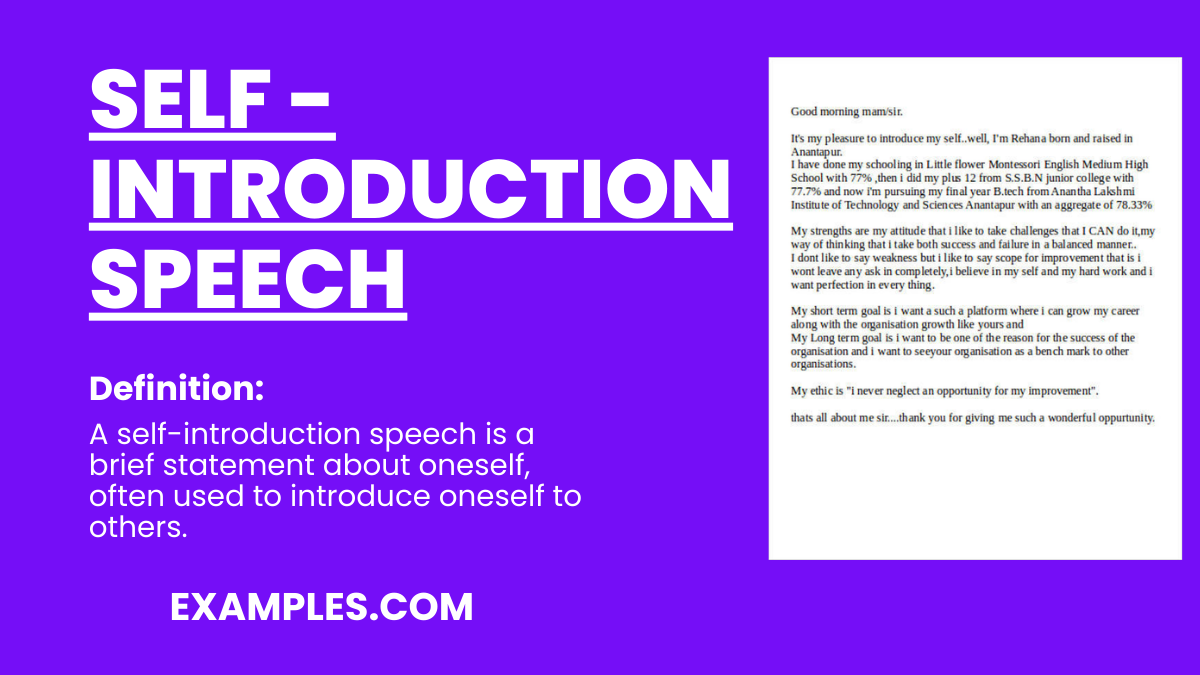
Back when we were still a kid, our parents will usually tell us that we “don’t talk to strangers.” That’s for our safety, of course. But how do we supposed to make friends when we were not allowed to talk to strangers? Right? Funny, but that is actually the case here. You may also see informative speech examples & samples.
We have to eventually introduce ourselves to random strangers. We may not want to but we have to. The technique here is to have a good self-introduction speech. It may sound professional, but it is actually easy to do, it’s more like creating a welcome speech . You don’t have to hire a speech writer or acquire a high level of speech skills.
What is Self Introduction Speech? A self-introduction speech is a brief presentation in which an individual introduces themselves to an audience. This type of speech serves to provide essential information about the speaker, including their name, background, and often their purpose for addressing the audience. It is an opportunity to make a positive first impression and establish a connection with the listeners. Self-introduction speeches are commonly used in various settings, such as formal presentations, social gatherings, job interviews, or public speaking engagements. The key elements typically covered in a self-introduction speech include personal details, professional background, and sometimes a glimpse into one’s interests or hobbies.
The Best Example of Self Introduction Speech in English
Good morning, everyone! My name is John Smith, and it’s an absolute pleasure to be here with you today. I am currently a Project Manager at Innovatech, where I’ve been leveraging technology to solve complex business problems for the past five years. I hold a Master’s degree in Business Administration from the University of XYZ, which equipped me with a solid foundation in strategic planning and operational efficiency. My passion for technology and innovation has been the driving force in my career, guiding me through various challenging yet rewarding projects. In my free time, I enjoy reading about emerging tech trends and dabbling in coding, which helps me stay ahead in this rapidly evolving field. I’m also an avid hiker, always seeking new trails to explore and appreciate the beauty of nature. I’m here today to share insights on ‘Effective Project Management in the Tech Industry’ and learn from all the distinguished professionals present. I look forward to engaging in thoughtful discussions and exchanging ideas that can propel us forward in our respective fields. Thank you for this opportunity to connect and grow together!
Format of Self Introduction Speech
Greeting and introduction.
Start with a Warm Greeting: Such as “Good morning,” “Hello,” or “Hi everyone.” State Your Name: Clearly introduce yourself.
Personal Background
Share Basic Personal Information: This could include your hometown or current place of residence. Mention Your Educational Background: Briefly state your highest level of education and the institution.
Professional Background
Current Position and Workplace: Describe your current job role and the organization you work for. Brief Career History: Outline your professional journey leading up to your current position. Key Achievements or Skills: Highlight any significant accomplishments or special skills you have.
Personal Interests or Hobbies
Share Your Interests: Briefly mention what you enjoy doing in your free time or any hobbies you have. Connect Interests to the Audience: If possible, relate your interests to the audience or the event’s theme.
Purpose of Your Speech
State the Purpose: Explain why you are giving this speech or your objective for being there. Link to the Event: If applicable, connect your introduction to the theme or topic of the event.
Closing Remarks
Express Gratitude: Thank the audience for their time and attention. Invite Interaction: If appropriate, indicate your openness to questions or further conversation.
Rehearse and Refine
Practice Your Speech: Rehearse to ensure fluency and to keep within any time constraints. Adjust as Needed: Tailor your speech to suit the audience and occasion.
Self Introduction Speech for School Students
Good morning everyone, respected principal, esteemed teachers, and my dear fellow students. My name is [Your Name], and I am thrilled to be a part of this amazing school community. Today, I am here to share a little about myself, my interests, and my aspirations. I am currently in [Your Grade], and I have recently joined this school. I come from [Your Hometown], a place known for its [Characteristic Feature of Hometown, like cultural heritage, natural beauty, etc.]. I have always been fascinated by [A Subject or Activity You’re Passionate About], which sparked my interest in [Related School Subjects or Clubs]. In my previous school, I was actively involved in [Mention any extracurricular activities you participated in, like sports, music, arts, etc.]. These activities not only shaped my skills but also taught me the importance of teamwork, perseverance, and dedication. Outside of school, I enjoy [Mention your hobbies or interests, like reading, playing a musical instrument, hiking, etc.]. I believe that these hobbies not only keep me energized and motivated but also allow me to explore my creative side. I am also deeply passionate about [Mention any social cause or issue you care about]. I have participated in [Mention any related events or activities, like community service, volunteering, etc.], which has been an incredibly rewarding experience for me. My aim during my time at this school is not only to excel academically but also to contribute positively to our school community. I am eager to join school clubs, participate in events, and collaborate with all of you on various projects. I am excited about the journey ahead and look forward to making lasting friendships and memories here. Thank you for giving me the opportunity to introduce myself, and I hope to get to know each of you better.
1 Min(Short) Self Introduction Speech for Students
Hello everyone! I’m [Your Name], currently a [Your Grade/Year] student at [Your School’s Name]. Originally from [Your Hometown], I moved here with my family [Time Period Ago, e.g., last year]. I’m really excited to be part of this vibrant school community. Academically, I have a keen interest in [Your Favorite Subjects, e.g., Science and Mathematics]. These subjects fascinate me because they challenge me to think critically and solve problems creatively. I aspire to utilize these skills in [Your Aspiration, e.g., becoming an engineer or contributing to scientific research]. Outside of academics, I’m passionate about [Your Hobby or Extracurricular Activity, e.g., playing soccer, coding, or playing the piano]. This hobby has taught me [A Skill or Value from Your Hobby, e.g., teamwork, patience, or attention to detail], which I find valuable in both my personal and school life. I also enjoy volunteering at [Any Volunteer Activity You Participate In], where I’ve learned the importance of community and helping others. It’s an experience that has enriched my understanding of social responsibility. My goal here is not just to excel in my studies but also to actively participate in school activities and clubs. I’m looking forward to making new friends, learning new things, and being a positive contributor to our school. Thank you for this opportunity to introduce myself. I’m excited about the journey ahead and am eager to get to know each of you!
2 Min Speech about Yourself Sample
Good day everyone! I’m [Your Name], and I’m genuinely excited to be here with you. I appreciate this opportunity to introduce myself and share a bit about my journey, aspirations, and interests. I hail from [Your City or Town], a place I hold dear for its [Unique Aspect of Your Hometown]. Currently, I am pursuing my studies in [Your Field of Study or Grade if you’re a student], and I’m passionate about [Mention your academic interests or subjects you’re passionate about]. My academic journey has been a blend of curiosity and a deep-seated desire to understand how things work, especially in the realm of [Mention a specific area, like technology, humanities, science, etc.]. Outside the classroom, I am [mention a personal hobby or interest]. This passion for [your hobby] has been a significant part of my life for the past [number of years you’ve been involved in the hobby], teaching me not just about [the hobby itself], but also about perseverance, patience, and the joy of mastering a skill. In addition to my studies and hobbies, I am actively involved in [Mention any extracurricular activities or volunteer work]. This involvement has allowed me to develop important skills such as [mention skills like leadership, communication, teamwork], and it has also given me the chance to give back to the community, something I find incredibly rewarding. Looking ahead, my goal is to [mention your future aspirations or goals]. I believe that the journey is just as important as the destination, and I am eager to embrace the challenges and opportunities that come my way. I’m also looking forward to learning from all of you, sharing ideas, and collaborating on exciting projects. I am here with an open mind, a thirst for learning, and a desire to contribute positively to our community. Thank you for listening, and I am excited about the prospect of getting to know each of you better!
How to Prepare Self Introduction Speech
Preparing an effective self-introduction speech involves careful planning and practice. It’s an opportunity to present yourself in a manner that is both informative and engaging. Here’s a guide on how to prepare for your self-introduction speech:
1. Understand Your Audience
- Audience Analysis: Consider the interests, expectations, and the level of formality of your audience.
- Context of the Introduction: Tailor your speech according to the occasion, whether it’s a professional setting, a classroom, or a social gathering.
2. Define Your Key Message
- Main Points: Decide on the main points you want to convey. Typically, these include your name, your background, your interests, and why you’re there.
- Unique Selling Point: Identify what makes you unique. This could be a specific skill, experience, or personal trait.
3. Structure Your Speech
- Introduction: Start with a hook – a question, a quote, an interesting fact, or a short story to grab attention.
- Body: Present your main points in a logical sequence. Include personal anecdotes or experiences to make your speech more relatable.
- Conclusion: Summarize your main points and end with a memorable statement or a call to action.
4. Personalize Your Speech
- Be Authentic: Speak about your genuine interests and experiences. Authenticity creates a connection with your audience.
- Reflect Your Personality: Let your personality shine through your speech. This makes you more relatable and memorable.
5. Practice, Practice, Practice
- Rehearse Aloud: Practice your speech multiple times to gain fluency. This also helps in managing your speech duration.
- Record Yourself: Recording and listening back can help you notice areas for improvement in delivery and pacing.
- Get Feedback: If possible, rehearse in front of someone and ask for constructive feedback.
6. Prepare for the Delivery
- Body Language: Use positive body language. Stand straight, make eye contact, and use hand gestures naturally.
- Voice Modulation: Use variations in your tone to emphasize key points and to keep the audience engaged.
- Pace Yourself: Speak clearly and at a moderate pace. Avoid speaking too fast, as it can make you seem nervous.
7. Plan for Q&A
- Anticipate Questions: Think about potential questions the audience might ask and prepare your responses.
- Engage with the Audience: Be ready to engage in a conversation post your introduction, if the format allows it.
Best Introduction Lines About Yourself
Introducing yourself effectively can set the tone for a meaningful interaction, whether it’s in a professional, academic, or social setting. Here are some engaging lines to introduce yourself that can be adapted to various contexts:
Professional Setting
- “Hello, I’m [Your Name], and I bring [Number of Years] years of experience in [Your Profession or Field], specializing in [Your Specialization].”
- “I’m [Your Name], currently leading the [Your Department/Team] at [Your Company], where I focus on [Key Aspect of Your Job].”
- “Good day! I’m [Your Name], a [Your Job Title] passionate about [Aspect of Your Job You’re Passionate About]. My work primarily revolves around [Brief Description of Your Work].”
Academic Setting
- “Hi, I’m [Your Name], a [Your Year, e.g., sophomore] at [Your School], majoring in [Your Major], with a keen interest in [Your Area of Interest].”
- “I’m [Your Name], currently pursuing my [Degree, e.g., Master’s] in [Your Field] at [Your University], where I’m deeply involved in [Your Research Topic/Area of Study].”
- “Hello everyone, I’m [Your Name]. As a [Your Grade/Year] student at [Your School], I’ve developed a strong interest in [Your Favorite Subjects or School Activities].”
Social or Informal Setting
- “Hi, I’m [Your Name]! In my world, you’ll often find me [A Hobby or Activity You Enjoy, e.g., hiking, reading, or cooking], or exploring [Something You Like Exploring, e.g., new cuisines, technology trends].”
- “I’m [Your Name], a lover of [Your Interest, e.g., music, books, sports], and always up for a good conversation about [A Topic You Enjoy Discussing].”
- “Hello, I’m [Your Name], and my friends describe me as [A Personality Trait or Interest, e.g., a creative thinker, an avid traveler]. I personally enjoy [An Activity or Interest, e.g., crafting stories, exploring nature].”
Specialized Interests
- “Hey there, I’m [Your Name], an enthusiastic [Your Hobby or Interest, e.g., gamer, photographer, cyclist] with a passion for [Related Interest, e.g., storytelling in games, capturing moments, long-distance cycling].”
- “I’m [Your Name], and my world revolves around [Your Passion, e.g., environmental advocacy, technological innovations]. I spend my time [Related Activity, e.g., organizing clean-ups, keeping up with the latest tech news].”
Volunteer or Community Work
- “Hello! I’m [Your Name], and I dedicate a significant part of my time to [Your Volunteering Work, e.g., animal rescue, teaching underprivileged children], which has taught me [A Skill or Value from Volunteering, e.g., patience, compassion].”
More Topics with Samples
- Self Introduction Speech for Elementary School
- Self Introduction Speech for Middle School
- Self Introduction Speech for High School
- Self Introduction Speech for College
- Self Introduction Speech for University
- Self Introduction Speech for Interview
- Self Introduction Speech for First Day at work
- Pageant Introduction Speech
How to Introduce Yourself in a Speech
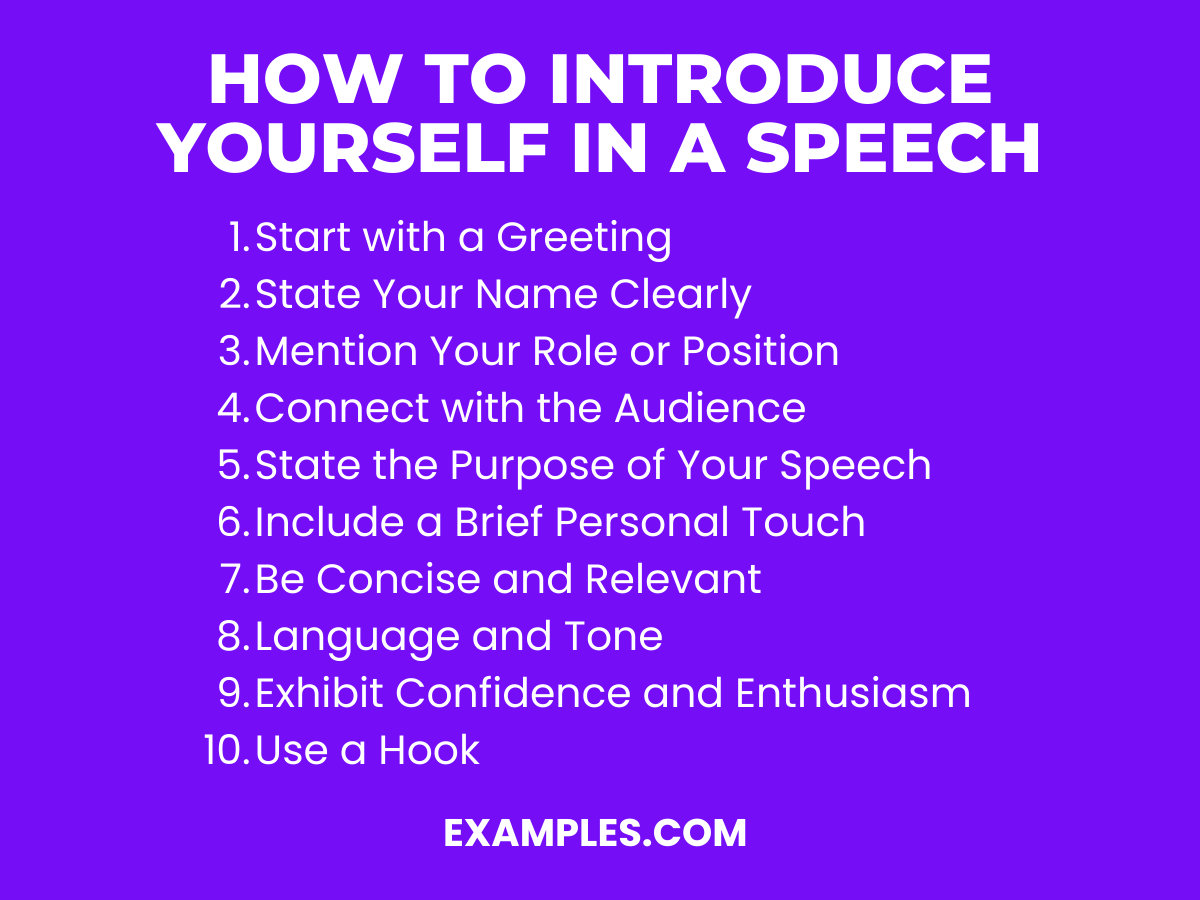
Self Introduction Letter For Job
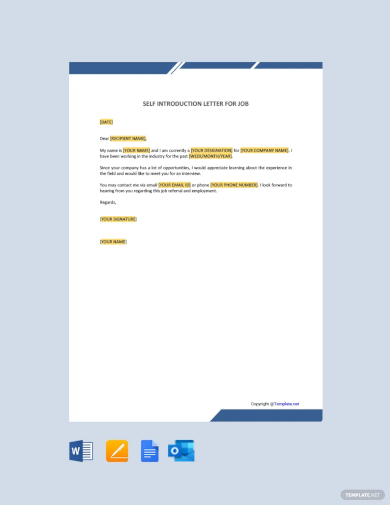
- Google Docs
- Apple Pages
Size: 37.4 KB
Client Self Introduction Example
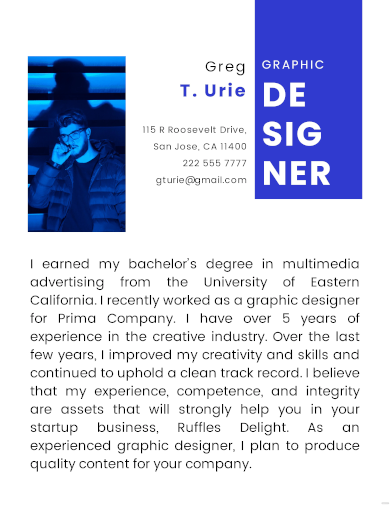
Size: 109 KB
Self Introduction For College Students
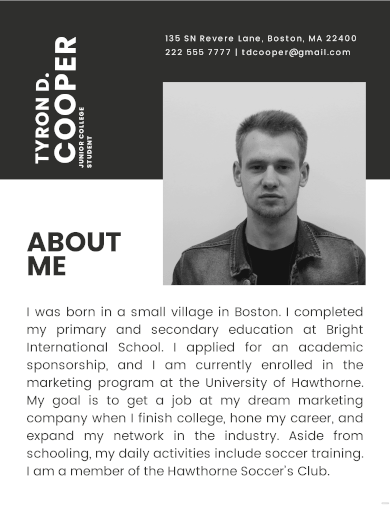
Size: 107 KB
Self Introduction For Job Example
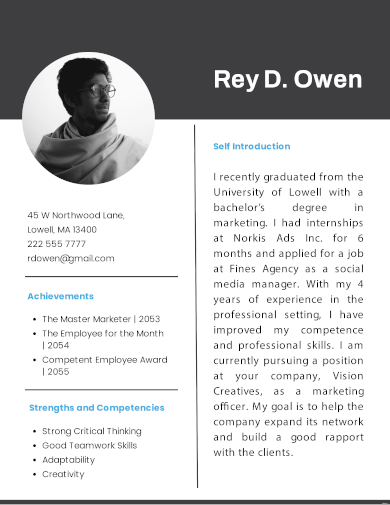
Size: 88.4 KB
Self Introduction For Kids Example
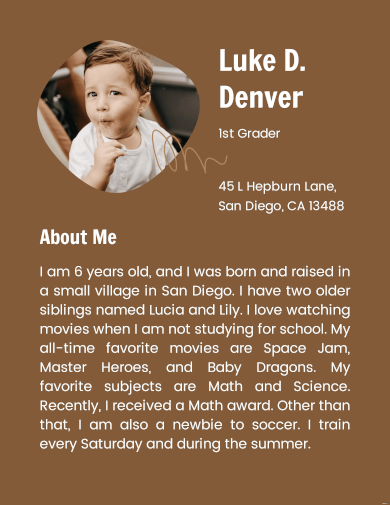
Size: 123 KB
Simple Self Introduction Example
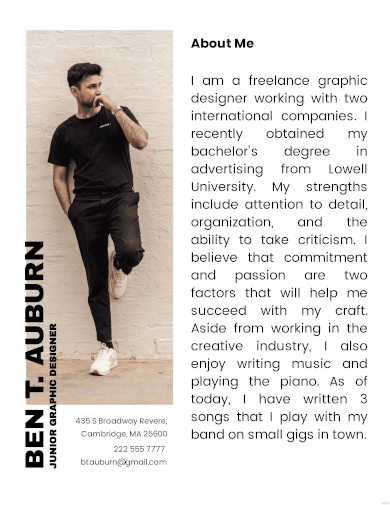
Size: 178 KB
Self Introduction Sample Example
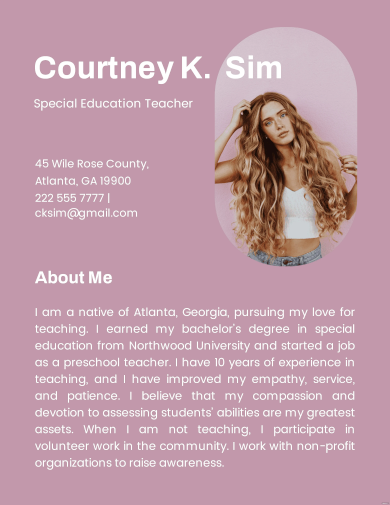
Size: 142 KB
Self Introduction For Freshers Example
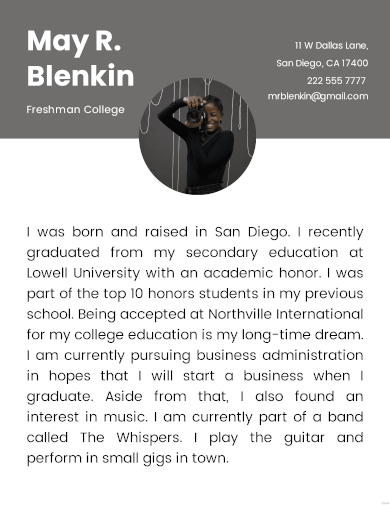
Size: 96.2 KB
Self Introduction For Interview Example
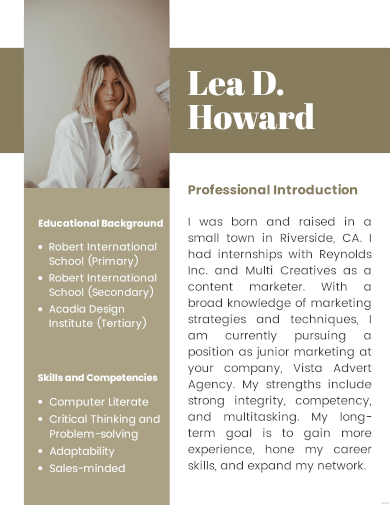
Size: 129 KB
Minimalist Self Introduction Example

Size: 120 KB
Creative Self Introduction Example

Size: 135 KB
Self Introduction for an Interview Example
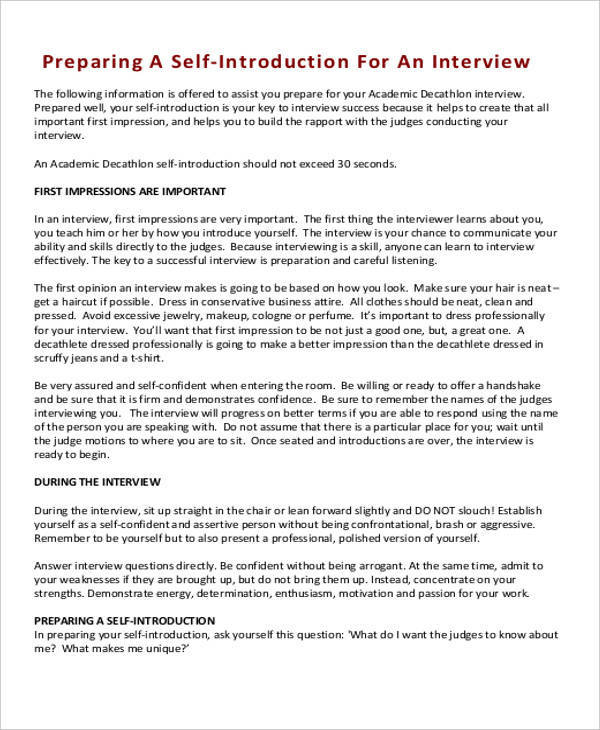
academicdecathlon.org
Size: 159 KB
Professional Self Introduction Example
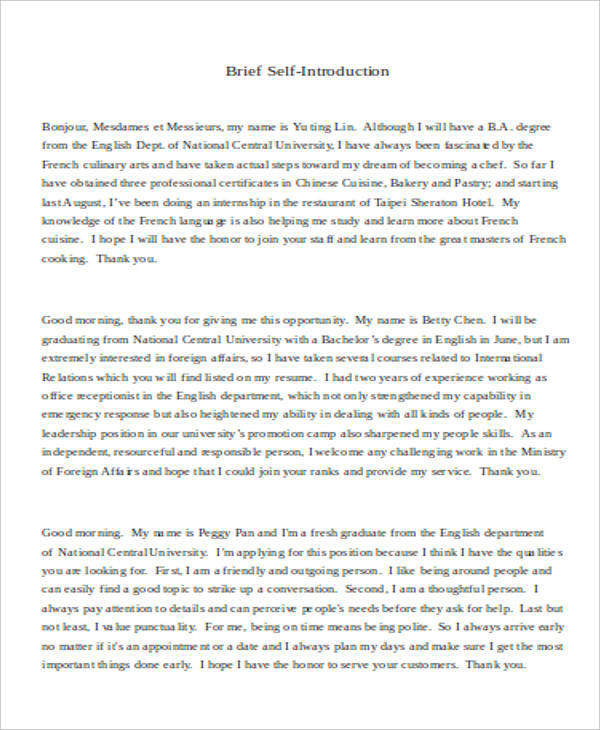
Size: 53 KB
Student Self Introduction Example
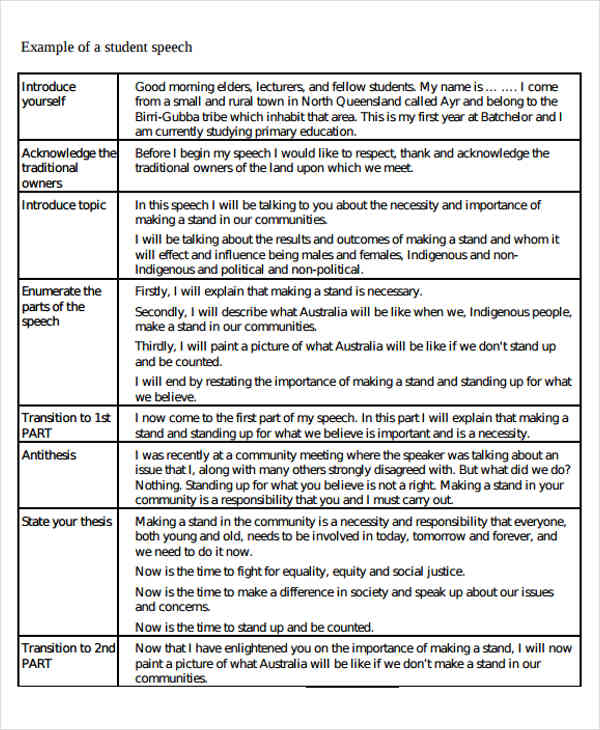
waalc.org.au
Size: 13 KB
How to Start a Self-Introduction Speech?
Introducing yourself to a group of strangers can be intimidating and awkward. But you can avoid this by crafting a proper and good self-introduction speech. You may also check out presentation speech examples & samples
Here’s how to start a self-introduction speech.
- Start by stating your full name clearly and your personal details. Say it out loud like you are giving a leadership speech .
- Mention where you from or an organization you belong.
- Give your personal and educational background. If it’s necessary, tell your family background
- Talk about your interest, hobbies or passion.
Formal Self Introduction Example
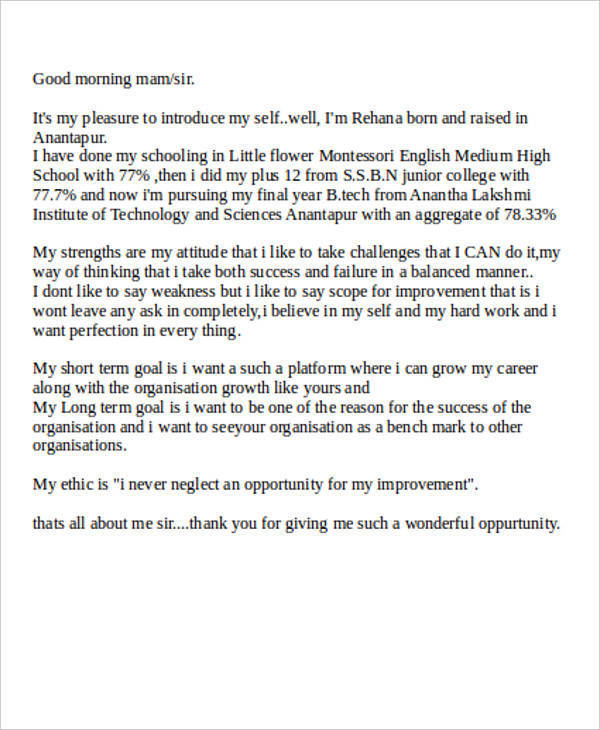
howtogiveselfintroductionininterview.blogspot.in
Size: 40 KB
Self Introduction to Employers Example
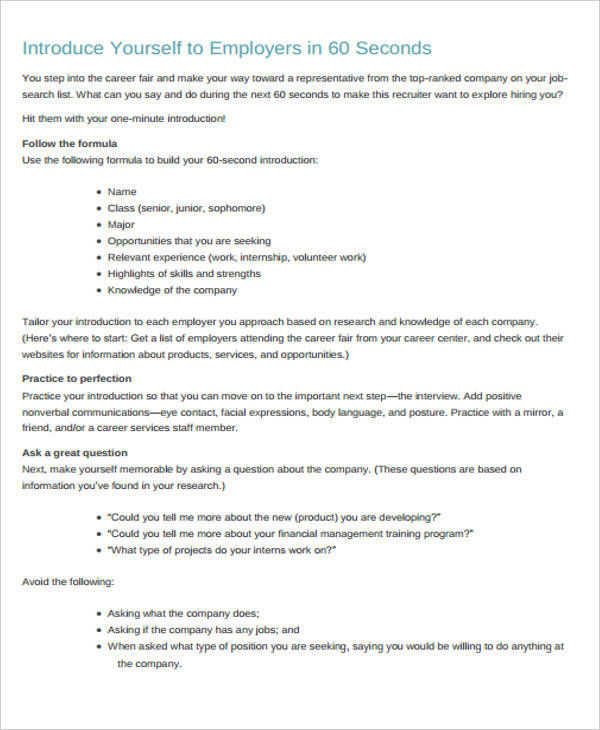
Size: 149 KB
Sample Self Introduction Example
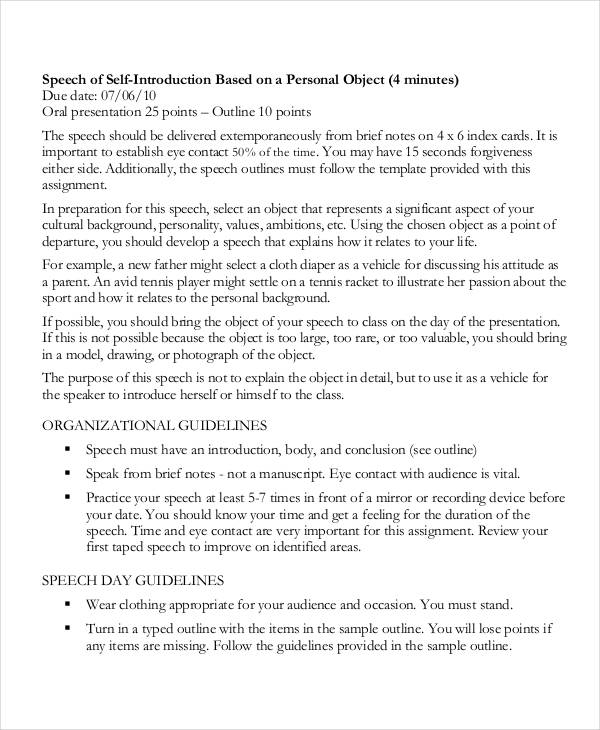
de.lbcc.edu
Size: 83 KB
Facts About Yourself
- Hometown: “I grew up in a small town known for its historic landmarks.”
- Education: “I have a degree in environmental science and am passionate about sustainability.”
- Career: “I work in graphic design and love bringing ideas to life visually.”
- Family: “I come from a family of five, and I’m the middle child.”
- Hobbies: “In my free time, I enjoy hiking and landscape photography.”
- Travel: “I’ve backpacked across several countries in Europe and Asia.”
- Skills: “I’m fluent in Spanish and have basic skills in sign language.”
- Volunteering: “I volunteer at an animal shelter on weekends.”
- Favorite Cuisine: “I’m a food enthusiast, with Italian cuisine being my favorite.”
- Unique Experience: “I once participated in a marathon and completed it, which was a big achievement for me.”
Tips for Self-Introduction Speech
Self-introduction speeches can be quite tricky and hard to do. There are lots of things to consider to deliver a better self-introduction speech. Still, it is extremely important as it gives you a good first impression that will have a big impact on how people perceive you. You may also see motivational speech examples & samples
1. Start with a Strong Opening
- Capture Attention: Begin with an interesting fact, a brief story, or a quote that relates to your personality or experiences. This helps to engage your audience from the start.
2. Keep It Concise and Relevant
- Be Brief: Remember, brevity is key. Stick to a few important points without going into too much detail.
- Stay Relevant: Tailor your introduction to your audience and the context of the occasion.
3. Share Personal Insights
- Personal Anecdotes: Include a short personal story or experience that gives insight into who you are.
- Unique Traits: Highlight unique aspects of your personality or background that make you stand out.
4. Be Enthusiastic and Positive
- Show Enthusiasm: Your tone and body language should convey enthusiasm. Smile and maintain a positive demeanor.
- Speak with Confidence: Confidence in your speech will make you more engaging.
5. End with a Purpose
- Closing Statement: End your introduction with a statement that indicates your purpose, your goals, or what you’re looking forward to in your new role or environment.
6. Practice and Prepare
- Rehearse: Practice your speech to ensure fluency and to manage its duration.
- Get Feedback: If possible, rehearse in front of a friend or family member and get their feedback.
7. Engage with Your Audience
- Eye Contact: Make eye contact with your audience to create a connection.
- Involve the Audience: If appropriate, ask a rhetorical question or make a statement that involves the audience.
8. Mind Your Language and Tone
- Clear and Simple Language: Use language that is easy to understand. Avoid jargon unless you are sure the audience will understand it.
- Appropriate Tone: Adjust your tone according to the formality of the occasion.
9. Use Humor Wisely
- Light Humor: If it comes naturally, a touch of humor can be effective, but it should be appropriate to the setting and audience.
10. Reflect and Adapt
- Be Adaptable: Be prepared to modify your speech slightly depending on the audience’s reaction.
- Continuous Improvement: Reflect on your performance and think about ways to improve for next time.
Text prompt
- Instructive
- Professional
Write a Self Introduction Speech for a new job.
Create a Self Introduction Speech for a university class.

30 Famous and Short Inspirational Speeches (5 minutes or less)
- December 13, 2023
This post is all about the best short inspirational speeches.

If you are in need of a quick boost of inspiration and motivation, you will find that in this post. I am one of those people who loves to get motivated. That sounds weird, right?
Well, a lot of people these days tend to give motivation a hard time because they don’t believe that it has lasting effects. In other words, they believe that what’s most important is your own self-discipline, because that’s what you have to rely on when motivation isn’t there.
And while I do agree with that sentiment in general, I will never pass up a great motivational podcast or YouTube video! 😀 There’s just something about them that even if they might not have lasting effects, they do truly help pump me up in the moment to get work done. And that’s usually what matters to me the most when I am looking for them in the first place.
So, here are the very best short motivational speeches so you can get that quick fix of motivation that you’re looking for, and ultimately move closer to your goals and dreams.
Short Inspirational Speeches
Believe in yourself speeches.
If you lack confidence or you are doubting yourself, these short motivational speeches will help you to believe in yourself again.
1. Rocky’s Inspirational Speech to His Son | ROCKY BALBOA
In less than 5 minutes, you’ll watch Rocky Balboa (Sylvester Stallone) explain to his son that if he wants to have the life he desires, he needs to believe in himself. He needs to stop listening to the people that tell him who he is, and instead go be his own person, and stop looking for someone to blame when things aren’t working out for him because ultimately it’s on HIM. This is one of the greatest inspirational speeches of all time.
2. Find Your Purpose | David Goggins – Motivational Speech
David Goggins is truly incredible. A former Navy SEAL, he has broken records and ran more races than you’d imagine. But the one thing that really stands out about him is his mindset.
Listen to this video if you want to be great. He tells you exactly what you need to do to get there.
Also, if you’ve never read David Goggins’ book “Can’t Hurt Me” , I highly recommend it. He talks about his rough upbringing, and how he was able to essentially become an entirely new person to become a Navy SEAL.
3. BELIEVE IN YOURSELF – Motivational Video (ft. Jaret Grossman & Eric Thomas)
This video is all about how important it is to have the proper belief system. If you truly believe that you are one of the best, you will start acting that you are one of the best, and eventually you may just be one of the best.
4. DON’T LET YOUR DREAMS DIE – Motivational Speech
This YouTube short by Mel Robbins is so good, I had to share it. A light bulb went on in my head when I first watched this. If there is something that is always on your mind, don’t let it haunt you forever because you never put yourself out there to try it. Go and DO!
Motivational Speeches About Not Giving Up
The following short motivational speeches are all about not giving up on your dreams. If you are losing hope, these short motivational speeches will inspire you to keep going.
5. Brené Brown It’s Not The Critic Who Counts
This speech will give you chills, and it is packed with great lessons about life. Brené Brown is a researcher who went viral for a Ted Talk, and here she talks about how to overcome critics and to keep believing in yourself no matter what. If you are worried about what people think of you, you NEED to watch this.
6. Amazing Motivational Speech by Denzel Washington
This is another video that gave me chills. The main theme of this famous speech is “ease is a greater threat to progress than hardship”. Stay consistent even when it’s hard. Easy task after easy task won’t get you to where you want to be.
7. Steve Harvey – Inspirational Speech | Motivational Short Video | Incredible You
This short motivational speech by Steve Harvey is short but impactful. If you are someone who stepped out of your comfort zone to pursue something really difficult, and you’re thinking about giving up, this speech may just prevent you from doing so.
8. Ed Mylett on The Power of One More
Ed Mylett shares the story of how his father stayed sober until his dying day, and how Ed himself uses that same philosophy to never give up. Personal stories like these are always the most inspiring.
By the way, if you REALLY want to push yourself and become the best, read Ed Mylett’s most recent book on this same topic, “The Power Of One More” .
Motivational Speeches If You’re Feeling Behind
Are you feeling behind in life? If so, let’s change that. Watch these videos to be reminded that you are on your own unique path. You have no competition other than your past self. These short motivational videos will help you believe that.
9. Before You Feel Pressure – WATCH THIS | by Jay Shetty
Jay Shetty talks to a school class about how there’s no one “perfect” life timeline to follow, and that we are all on our own clock.
10. Kevin Hart Motivational Speech
If you’ve made mistakes in your life (haven’t we all) this is a great story from Kevin Hart (famous comedian and actor) that will remind you of the power of making mistakes and pushing through hard times.
11. Oprah Winfrey | 5 Minutes For The NEXT 50 Years of Your LIFE
In this video, Oprah talks about the importance of really knowing who you are and what you want in your life. She talks about surrounding yourself with great people, and how to have enormous success. “Let excellence be your brand.”
Listen To These If You Need Perspective
Sometimes in life, we get so caught up in the day to day that we forget what truly matters – the people we love. If you are having trouble with something in life, give these videos a listen, because they just might help you realize what is really important.
12. Arnold Schwarzenegger – Organize Your Day | 1 MINUTE MOTIVATIONAL VIDEO
Are you the kind of person who always complains that you don’t have enough time to do something? If so, you’re not alone. We are all busy humans, running around doing a million things. But if you aren’t prioritizing what you know you should be doing, listen to this video.
13. How to Judge Your Life Using 3 Simple Questions | Brendon Burchard Speech| Goalcast
Have you ever heard of Mortality Motivation? It’s essentially what it sounds like… being motivated by the impending reality of your death. It sounds a little morbid, but it’s actually quite beautiful and it can be really beneficial if you harness it for good.
In this video by motivational speaker Brendon Burchard, he shares how a car accident when he was 19 gave him mortality motivation and changed everything for him.
14. FALL, SUFFER AND LEARN | MOTIVATIONAL SPEECH BY OPRAH WINFREY
This speech by Oprah was given to Harvard graduates, and it’s a unique speech because she talks about failing, even after the major success of her television show for over 20 years.
It’s refreshing to hear that even the most successful people fail. What really matters, though, is what you do with your failure. Do you learn from it and move on? Or do you give up?
15. YOU VS YOU – Best Motivational Video
This is a pretty intense video about competition. If your #1 competition is someone else, you need to change your perspective. Your only competition is YOU. The only thing preventing you from moving forward is you.
16. The Speech That Brought This Entire School To Tears
This is a speech about a man who never really paid much attention to his mother, until she passed away. It’s an emotional reminder to cherish the time you have with your loved ones, because you never know if the next time you see them will be the last time.
In my opinion, this speaker embodies many qualities of the best motivational speakers because he really knows how to capture the audience’s attention and pull on their heart strings.
17. 5 Minutes to Start Your Day Right! – MORNING MOTIVATION
This motivational speech is by a Navy SEAL who will remind you to start each day with a task completed, respect everyone, take risks, step up during tough times, and never give up. If you do these things, the next generation, and the generations that follow, will live better lives than we live today.
18. The Real You – Jim Carrey
This video is one of the best motivational speech examples because it reminds you of something so important: sometimes we can be so focused on earning more money, gaining fame, and becoming admired that we lose ourselves or we lose sight of what’s really important to us in the process.
Jim Carrey talks about how he is a great example of that. He got all of the money, fame, and admiration, and admits that that wasn’t really who he was. Sometimes it’s nice to be reminded that money and fame, or even getting to the top of the corporate ladder, while nice, aren’t going to be the thing that brings you fulfillment when it’s all said and done.
19. Ed Mylett Motivational Speech
I posted another motivational video by Ed Mylett above, but if you don’t know much about him, prepare to have your world rocked. He’s probably my absolute favorite motivational speaker because he is successful and he works hard, but he’s also (seemingly) a kind, family guy who’s been through a few things.
In this video, he talks about being “the one” that changed his family tree. Take a listen because I’m sure it’ll get you thinking on whether or not you can be “the one” in YOUR family.
P.S. If you love personal growth content, you should check out Ed Mylett’s podcast . I listen to it every week and it is one of my favorites.
20. If You Feel LOST, LAZY & UNMOTIVATED In Life, WATCH THIS! | Tony Robbins Motivation
If you are someone who is constantly blaming others or your circumstances for your unhappiness, you need to listen to this video by Tony Robbins . Bad things happen to us all, it’s up to you to focus on what you can control.
Great Inspirational Speeches About Hard Work
How hard do you think you work? Could you be doing more? If there’s a little voice inside of your heart that knows you could be doing more and better, these motivational videos about the value of hard work will help you push yourself.
And a side note: your chances of having good luck increase the harder and longer you work.
21. You’re Not Tired, You’re Just Weak – David Goggins Motivation
If you’re feeling lazy or like you don’t want to do something, watch this video til 2:25 . It will give you the push you need to put your head down and do the work. It’ll remind you to keep pursuing your goals and to keep challenging yourself. Key takeaway: push yourself beyond your perceived limits.
22. Hard Work & Patience – A Gary Vaynerchuk Original Film
If you want to be motivated to work hard, listen to Gary Vaynerchuk. Gary Vaynerchuk is a creative genius known for his marketing tactics. This famous motivational speech is all about playing “the long game”, as in, working for a long time and having patience instead of working hard for a short period of time and expecting to win quickly.
23. OBSESSION – Best Motivational Speech
This is one of my favorite short motivational speeches because it makes me feel a little more normal for being “weird”. I’m the kind of person who chooses to work on the weekends instead of hanging out with people. Crazy, right? But it’s because I’m working toward a dream of mine and it’s something that’s really important to me. The most important thing to remember: it’s okay to devote yourself to something. It’s the only way to get what you want in life.
24. WORK LIKE HELL – Best Motivational Video
This is a series of motivational speeches about doing a little bit more and outworking your competition. I’m not going to lie – I’m up late writing this post and listening to this very video is what’s motivating me to keep going.
25. The video EVERY woman should watch!
Whether or not you’re a Rachel Hollis fan may be up for debate (and that’s okay!) but I happen to think she’s a great motivational speaker. This entire speech will inspire you to work hard and take massive action – today.
26. NEVER SURRENDER – Powerful Motivational Speech (by Kobe Bryant)
This one minute video by the late Kobe Bryant is one of the most famous short speeches. I read a book recently by his former personal trainer and I learned that Kobe really outworked everyone. He talks about a quote in this video that really stuck with him, and I think it’s great advice if you’re the kind of person who needs motivation to keep working hard.
Motivational Speeches About Working Smart
Have you ever heard the saying “work smarter, not harder”? That saying is all about ensuring that the work you are doing is actually efficient. Are you getting to where you want to go with all of the work that you are putting in? Are you getting closer to your goals and your dreams? Or are you sprinting like a hamster on a wheel and just running in circles?
Here are great videos on the importance of working hard but also working intentionally.
27. SET SYSTEMS RATHER THAN GOALS – Motivational Speech – James Clear
A goal gives you a sense of direction, but if you don’t spell out precisely how you are going to get to a goal, it is useless. You must develop systems. Listen to this James Clear video to gain valuable life lessons.
By the way, James Clear is an author who wrote perhaps my favorite book of all time: “Atomic Habits” . It’s life-changing if you haven’t read it yet.
28. Matthew McConaughey | 5 Minutes for the NEXT 50 Years of Your LIFE
This is one of the best motivational speeches of all time about how to live a great life for YOU. It’s filled with little pieces of wisdom that’ll really get you thinking about how you live your life and in what direction you want to go.
29. Visualization is the key – Bob Proctor
Do you believe in the Law of Attraction? If not, I have to say I’m surprised! I’ve experienced it in my own life more than once, and it is incredibly powerful. Here’s a great video that sums up the power of visualization, and if you want to learn more about the Law of Attraction or manifestation in general, read this post .
This video shows the true power of words, thoughts, and feelings that you have.
30. How to Stay Motivated – Carla Harris
Here is a YouTube short with very practical advice from Carla Harris on HOW to stay motivated. It’s all about having a vision!
This post was all about short inspirational speeches. Which one was your favorite?
Related Posts

Taylor Hayes & Suzie Becker – A Candid Convo About Imperfection

Feeling Stupid? Here Are 50+ Funny, Inspiring Quotes

100 Funny Work Affirmations For A Positive Day

About Taylor
A few years after graduating college, Taylor made it her mission to become debt free. After paying off all $60k of debt, she began to blog about what she's really passionate about: personal development. Nowadays, Taylor blogs about the topics of Mindset, Money, Health, and Career for women.

"It's Per$onal" is a super popular and anonymous blog series about the personal lives and finances of women all over the world. Check it out!

If you like this post, you might like these, too!

120 Powerful Buddhist Quotes That’ll Change Your Life

My Little Sister Got Engaged Before Me: Here’s How I’m Navigating This

IMAGES
VIDEO
COMMENTS
Tailor your content to your audience and purpose. First, determine who your audience is. It could be work colleagues, classmates, a hobby group, etcetera. Think about how big the audience will be, what the age range will be like, and why the audience has gathered. Then, think about what your audience is interested in.
The key to a good self-introduction speech is balance. You want to present your accomplishments but without coming off as bragging. Typically, this type of speech is known as an "icebreaker" as it aims to break the ice and let others know you. This is your chance to establish good credibility. Fear not!
10 Tips for Writing and Making a Self-Introduction Speech. Here are some tips to keep in mind while writing and giving your self-introduction speech. The most important tip, however, is to do what feels natural and flows easily. ... You can start with an interesting fact about yourself, a short story, or a joke if the setting is informal. Keep ...
Generally, the timing allowed for a self-introductory speech is between 1 - 2 minutes. (About 150-300 words.) Going over that is poor form because it eats into the time allocated for everybody to speak. In addition, rambling on without being mindful of the larger group could be interpreted as boring and/or egotistical.
If you need to introduce yourself in class, during a toast, or before a business presentation, it helps to be prepared. Use these examples to craft your next About Me speech.
4. Keep in mind the details. If you do not know how to give a speech about other person or yourself, and it will be your first experience, you should pay attention to details. Wear clothes should fit the format and be comfortable. This will always make a good impression on the audience, your appearance will conclude a general impression of you, and this is why your appearance should be nice ...
Download Article. 1. Make an outline of your speech. Start by making a skeletal draft of your main points. Strip the speech down to its bare bones to determine what is most important to say, and in what order you should deliver those facts. This is the basic structure which you will build your speech around.
Here is a simple structure to follow: Introduction: Start with a captivating opening that grabs your audience's attention. Introduce yourself briefly and state the purpose of your speech. Main Body: Divide your speech into sections or paragraphs, with each focusing on a specific key experience.
If you want to write a 2-minute speech about yourself, then it's important to write about what matters since time is so limited. If you want to freshen up your writing, review types of sentences for a memory boost. But don't stretch yourself too thin. Let's look at an example of how to write a speech. Let's say you're writing a speech ...
When deciding how to deliver a pitch, work on cultivating welcoming body language but respecting their personal space. You should also make eye contact to keep them listening and try to convey a calm and relaxed demeanor to show them your confidence. 2. Tweak your pitches.
Sample Introduction Speech Topics. Look at the sample self introduction speech topics and pick out the aspects of your personal life you want to share with the audience. Approach the list below with the who, the what, the whereabouts, for sure the why, the how and when questions. That is an effective way to outline your first thoughts.
5. Personal interests: Wrap up your self-introduction by mentioning a few personal interests or hobbies, which can help to humanize you and make you more relatable. For example, "In my free time, I love hiking and exploring new trails. I'm also a big fan of trying out new restaurants and cooking at home.".
A Simple Way to Introduce Yourself. by. Andrea Wojnicki. August 02, 2022. Bernd Vogel/Getty Images. Summary. Many of us dread the self-introduction, be it in an online meeting or at the boardroom ...
How to write a five-minute speech. Here are the steps you can follow to prepare and deliver a short speech: 1. Prepare. Short speeches require preparation because you have to condense your information into only the most useful points. The first step in preparing a brief speech is to determine the purpose of your talk.
Follow these steps to learn how to write a memorable introduce yourself speech: 1. Start with a strong introduction. Write the introductory part of your speech in a way that gets the attention of your audience and makes them want to listen to what you have to say. This step is essential to ensure that your audience follows through with your ...
You should feel empowered—not intimidated—in taking on a writing project about yourself. Use it as a way to challenge how you view your own experiences, talents, and more. We'll discuss some steps for writing about yourself as well as provide a few examples. Steps for Writing About Yourself. Writing isn't for everyone, especially when ...
Here's a guide on how to prepare for your self-introduction speech: 1. Understand Your Audience. Audience Analysis: Consider the interests, expectations, and the level of formality of your audience. Context of the Introduction: Tailor your speech according to the occasion, whether it's a professional setting, a classroom, or a social gathering.
Do your research. To introduce yourself in the best possible way, find out as much as you can about the company you're applying to. Make sure you're a cultural fit. And learn how to answer them what are you passionate about question. Control your body language. Body language communicates much more than you think.
Focus on a specific moment, and describe the scene using your five senses. Mention objects that have special significance to you. Instead of following a common story arc, include a surprising twist or insight. Your unique voice can shed new perspective on a common human experience while also revealing your personality.
2. Consider your body language. When you introduce yourself to someone, you can demonstrate confidence by speaking in a clear and audible voice and communicating a positive attitude through nonverbal cues. During your conversation, maintain natural body language to show you are open. Example: When you approach a new coworker in your department ...
Yes. The introduction is a paragraph. That's the whole rule. With that said, it can be two paragraphs, it can be ten paragraphs, and it can be a page. The length of your introduction is dependent on several factors: who you are writing for, how much time you have to write, how detailed you want to get, and how much detail your reader can absorb.
Use a casual and friendly tone. 1. Develop a strong introduction. A concise, informative self-introduction can immediately interest the reader and make them more likely to continue reading the rest of your document. Write a short statement that accurately describes your skills and qualifications.
If you lack confidence or you are doubting yourself, these short motivational speeches will help you to believe in yourself again. 1. Rocky's Inspirational Speech to His Son | ROCKY BALBOA. In less than 5 minutes, you'll watch Rocky Balboa (Sylvester Stallone) explain to his son that if he wants to have the life he desires, he needs to ...